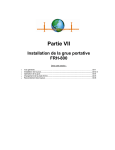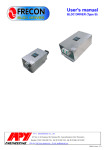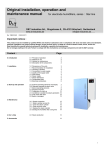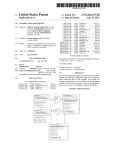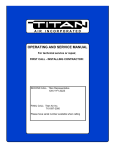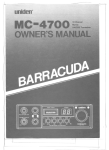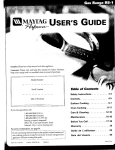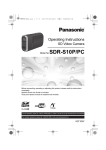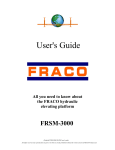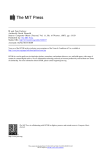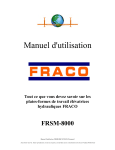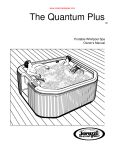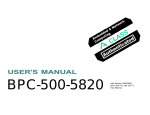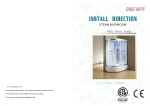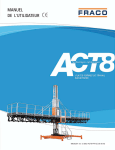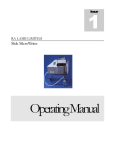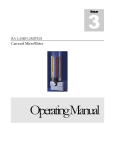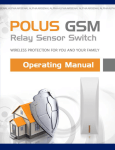Download FRSM-8000 Mast Climbing Work Platform User`s Manual
Transcript
User’s Guide All you need to know about the FRACO hydraulic elevating platform FRSM-8000 [English] FRSM-8000 05/2010 user’s guide All rights reserved, Any reproductions in part or in whole is stricly prohibited without the written consent of FRACO Products Ltd Model FRSM8000, ACT4, ACT8, 20K Technical Date of issue 2010-03-30 Bulletin n° U-G-0012-A FRACO Utilization specifications concerning the universal freestanding base and the freestanding base specific to each type of platform To be added to FRACO platforms User’s manual for models indicated above Please read the following technical service bulletin carefully and insert it in the appropriate FRACO user’s manual. Characteristics specific to the FRSM 20K freestanding base (#14030053) and universal freestanding base (# 14030109). Corresponding authorized freestanding heights and opening specifications of the stabilizers. ITEM # 1 2 3 4 5 6 7 Description Width Number of jacks Front stabilizers Rear stabilizers Usable with Freestanding heights Use with Ground base Model FRSM 20K freestanding base #14030053 (figure 1) 215” (5.46m) Universal freestanding base #14030109 (figure 2) 150” (3.81 m) 6 4 Extendable up to 16‘’ [0.4 m] Extendable up to 36’’ [0.9m] ACT4 ACT8 20K 25’-0’’ 40’-0’’ 40’-0’’ [7.62m] [12.2m] [12.2m] Not Not Not Required Required Required Figure 1 2001© Les Produits FRACO Products ltée/Ltd. Extendable up to 48’’ [1.2m] Extendable up to 28’’ [0.7m] FRSM8000 ACT4 ACT8 35’-0’’ 60’-0’’ 45’-0’’ [10.6m] [18.3m] [13.7m] B A, C, D A, C, D 20K 45’-0’’ [13.7m] A, C, D Figure 2 1/3 Technical Model FRSM8000, ACT4, ACT8, 20K Date of issue 2010-03-30 Bulletin n° U-G-0012-A FRACO Freestanding heights specifications 1. The freestanding height is determined by the distance measured between the bottom of the jacks (ground) and the top of the platform floor. (see figure 3 and 4) 2. See figure 4 or the appropriate user’s manual to identify the base required for the type of elevating unit used. 3. Refer to the appropriate user’s manual for the instructions regarding proper installation and dismantling procedure for each specific unit. Figure 3 ITEM # 5 6 7 Description Usable with Freestanding heights Use with base Model Figure 4 FRSM 20K freestanding base #14030053 (figure 3) ACT4 ACT8 20K 25’-0’’ [7.62m] Not Required 40’-0’’ [12.2m] Not Required 2001© Les Produits FRACO Products ltée/Ltd. 40’-0’’ [12.2m] Not Required Universal freestanding base #14030109 (figure 4) FRSM ACT4 ACT8 20K 8000 35’-0’’ 60’-0’’ 45’-0’’ 45’-0’’ [10.6m] [18.3m] [13.7m] [13.7m] B A, C, D A, C, D A, C, D 2/3 Technical Model FRSM8000, ACT4, ACT8, 20K Date of issue 2010-03-30 Bulletin n° U-G-0012-A FRACO Stabilizer opening specifications 1. The front and rear stabilizers of every freestanding base (specific to each type of platform) must be extended to their maximum in order to reach the maximum heights and load capacities specific to each type of equipment in freestanding mode (except the universal freestanding base). (see chart below) 2. When using the universal freestanding base, the front and rear stabilisers must be extended to a minimum of 1’-9’’ (533.4 mm ). This measure is designated by the distance between the face of the stabiliser insertion tube and the jacks. (see figure 5. detail 1). 3. For any situation and for each type of platform, the planking area must never exceed the front stabilisers of the freestanding base. (see figure 5, detail 2) Type of platform FRSM-1500 FRSM-3000 FRSM-8000 ACT-4 ACT-8 20K Maximum height on platform specific freestanding base 35’-0’’ (10.7 m) 35’-0’’ (10.7 m) 35’-0’’ (10.7 m) 60’-0’’ (18.3 m) 45’-0’’ (13.7 m) 40’-0’’ (12.2 m) Maximum height on universal freestanding base Maximum authorized load NA NA 35’-0’’ (10.7 m) 60’-0’’ (18.3 m) 45’-0’’ (13.7 m) 45’-0’’ (13.7 m) 1500 lbs (680 kg) 3000 lbs (1360 kg) 8000 lbs (3630 kg) 4000 lbs (1815 kg) 8000 lbs (3639 kg) 10 000 lbs (4535 kg) Figure 5 Failure to comply with the instructions as stated in the user’s manual or any documentation produced by the manufacturer can lead to material damages, serious injuries and/or even death. For further information’s or any questions please contact: Jean-Sébastien Lasnier Telephone: 450-658-0094 Toll Free: 800-267-0094 Fax: 450-658-8905 2001© Les Produits FRACO Products ltée/Ltd. 3/3 Technical Model 20K, FRSM-8000, ACT-8 Date of issue Bulletin n° 2010-04-12 U-T-0008-A FRACO Specification for utilisation of 10’-6’’ (3.2m) outriggers #19010045 Add to FRACO platforms User’s Guides for models indicated above Please read the following carefully and insert in your Fraco User’s Manual: When using 10'-6''(3.2m) outriggers, the maximum length on which you can work on is 6 '(1.8m). Complete assembly view of 10’6’’ outriggers Figure 1: Lower part outriggers Figure 2: Upper part outriggers Note: 1. 2. 3. The distance is designated by the measurement from the face of the platform to the very end of the outrigger. (See Figure 1 and 2) This distance applies when outriggers are installed at either the lower or upper part of the platform. (See Figure 1 and 2) When using 10'-6''(3.2m) outrigger to their maximum length of 7 ' (2.1m), you must use accompanying parts found in the # 19510073 kit and install it according to the user’s manual. The outriggers must be installed in the upper part of the platform. 2001© Les Produits FRACO Products ltée/Ltd. 1/2 Technical Model 20K, FRSM-8000, ACT-8 Date of issue Bulletin n° 2010-04-12 U-T-0008-A FRACO Important change when using the outrigger kit #19510073 1. When using 10’-6’’ (3.2m) outriggers to their maximum deployment of 7’-0’’ (2.1m), the utilization of the outrigger kit 19510073 (see figure 3) is required and the installation must be done in accordance with the procedure presented in the user’s manual. 2. When using 13’-6’’ (4.14 m) the maximum distance which it can be extended is now of 8’-0’’ (2.44m) (see figure 3, detail A). ). The utilization of the outrigger kit 19510073 (see figure 3) is required and the installation must be done in accordance with the procedure presented in the user’s manual. Complete assembly view of 10’6’’ outriggers and 13’6’’ with outrigger kit #19510073 Figure 3 A Detail A Important: 1. The forged steel (see figure 3 Detail A) 3/8’’ x 3’’ x 4 ½’’ ( #28018111 ) of the outrigger special swivel tie ( # 20490555 ) must be replaced by a forged steel 5/8’’ x 3’’ x 4 ½’’ H.R. grade 44W ( # 28026794 ). 2. The 2 bolts BOZ-7186 (1/2’’-13 UNC x 3-3/4’’ gr5 zinc) must be replaced by 2 bolts BOZ7190 (1/2’’-13 UNC x 4’’ gr 5 zinc). (see figure 3, detail A). 3. For distance exceeding 8’-0’’ (2.44 m) on the face of the platform, utilization of reinforced working platform (#20990280) is required. Failure to comply with the instructions as stated in the user’s manual or any documentation produced by the manufacturer can lead to material damages, serious injuries and/or even death. For further information or any question please contact: Jean-Sébastien Lasnier Telephone: 450-658-0094 Toll Free: 800-267-0094 Fax: 450-658-8905 2001© Les Produits FRACO Products ltée/Ltd. 2/2 Technical Model 20K, FRSM-8000, ACT-8 Date of issue Bulletin n° 2007-02-01 U-T-0005-A FRACO Installation procedure for ’’Z’’ Bridge Arm Add to FRACO platforms User’s Guides for models indicated above Please read the following carefully and insert in your Fraco User’s Guides: Complete assembly view If you are already using these bridge arm, check all your jobs sites to see if the installation comply with this procedure. Note: all set-up using “Z” bridge arm must be approved and authorized by Fraco. For further informations or any questions please contact: Jean-François Laurin T.P. or Jean-Sébastien Lasnier T.P. Telephone : 450-658-0094 Toll Free : 800-267-0094 Fax : 450-658-8905 2001© Les Produits FRACO Products ltée/Ltd. 1/3 Technical Model 20K, FRSM-8000, ACT-8 Date of issue Bulletin n° 2007-02-01 U-T-0005-A FRACO Installation of ’’Z’’ Bridge Arm support • Install the ‘’Z’’ Bridge Arm support on the extension. • Secure the support with supplied fastening hardware (FOI-1656), drill holes in the plywood’s of the extension. • Make sure that you secure the support to the structure of the extension section. • Tighten all bolts and nuts. Installation of ’’Z’’ Arm • Insert the lower part of the ‘’Z’’ Bridge Arm in proper position of the bridge. (Remove the standard bridge arm) • Lock them in place with bolts and nuts. 2001© Les Produits FRACO Products ltée/Ltd. 2/3 Technical Model 20K, FRSM-8000, ACT-8 Date of issue Bulletin n° 2007-02-01 U-T-0005-A FRACO Bridge installation on the cantilever section • Lower the Bridge Section on the extension, the upper part of the ‘’Z’’ Bridge Arm must sit on the fixed support. • Secure the ‘’Z’’ Bridge Arm on it’s support with supplied hardware. 2001© Les Produits FRACO Products ltée/Ltd. 3/3 Model All General Date of issue 2006-12-19 Bulletin n° U-T-0002-A Mast climbing work platform Mast bolt assembly procedure Amendment to all the FRACO platforms User’s Guide Please read carefully the present letter and insert it in all your Fraco User’s Guide: All mast bolts must be installed head down and washer must be positioned on the nut side (see illustration). Always tighten the nut. See user’s guide for specific bolt torque. The most recent versions of our user’s guide are available on our Web site (www.fraco.com). Please refer to them for assembly procedures with regards to changes above. For more information, contact our Technical Department: Julie Rainville Technical Service Director Fraco Products T: 800-267-0094 / 450-658-0094 F: 450-658-8905 2001© Les Produits FRACO Products ltée/Ltd. 1 Model All Information Date of issue 2006-12-06 Bulletin n° U-T-0003-A Mast climbing work platform High priority warning: Height of the first and second wall tie Amendment to all the FRACO platforms User’s Guide Please read carefully the present letter and insert it in all your Fraco User’s Guide: Fraco is changing the anchoring procedure for all types of platforms when using ground base. The most recent versions of our user’s guide are available on our Web site (www.fraco.com). Please refer to them for installation procedures with regards to changes below. The two first ties must be at 10 and 20 feet ( 3m and 6 m) or at the two first accessible structural levels on the building (max 20’) ( max 6 m ). This new procedure is to upgrade the safety of our platform during the operation of installation and dismantling. The platform must be secured by lifting equipment while installing or dismantling the two first ties. Once the second tie is in place, the installation continues by the usual procedure; reduce load platform (1/2 load) except the ACT-4 and the anchoring sequence typical for the type of platform in use as shown below: FRSM-1500, FRSM-3000, FRSM-8000 : 20 feet ( 6 m ) ACT-8 et FRSM-20 K : 30 feet ( 9 m ) ACT-4 : 40 feet ( 12 m ) For more information, contact our Technical Department: Julie Rainville Technical Service Director Fraco Products T: 800-267-0094 / 450-658-0094 F: 450-658-8905 2001© Les Produits FRACO Products ltée/Ltd. 1 Model 20K, ACT-8, FRSM-8000 Technical Date of issue Bulletin n° 2007-01-17 U-T-0004-A FRACO Procedure installation for Hybrid Bridge Add to FRACO platforms User’s Guides for models indicated above Please read the following carefully and insert it in your Fraco User’s Guides: Hybrid Bridges Please find attached the procedure for installation of hybrid bridges. These bridges can be used as extensions as well. For further information or any question please contact: Jean-François Laurin T.P. or Jean-Sébastien Lasnier T.P. Telephone : 450-658-0094 Toll Free : 800-267-0094 Fax : 450-658-8905 2001© Les Produits FRACO Products ltée/Ltd. 1/5 Installation of hybrid bridge sections Step 1 (see Figure D.5 et Vue A) - - Step 2 (see Figure D.6) Bolt the sections together with 4 bolts of Ø1 in.-8unc x 9 in. on the bottom of the bridge sections. Bolt the sections together with 2 bolts of Ø3/4 in.-10unc x 4 1/2 in. on the top of the bridge sections. Position the pin with chain in the plate with holes (see View A). - Position the first pin on the top of the bridge arm and bloc it with a spring pin. Slide the bridge arms on the pockets of the bridge sections. Place a locking bolt ؽ in.-13unc x 3 ¾ in. and a lock nut ؽ in.-13unc at the back end of the bridge arm. Bolt BOA-2032 with washer and nut O3/4 in.-10unc x 4 1/2 in., gr 5 warning: 2 boltss on the top Bolt BOA-2085 with washer and nut O1 in.-8unc x 9 in., gr 5 warning: 4 bolts on the bottom A Locking pin with chain supplied with the bridge section 1 View A Figure D.5 Locking pin supplied with the bridge arm Spring pin supplied with the bridge arm Nut NYL-2030 O1/2 in.-13unc Bolt BOZ-7186 O1/2 in.-13unc x 3 3/4 in., gr5 2 Figure D.6 1/4 Installation of hybrid bridge sections (continued) Step 3 (see Figure D.7) - Step 4 (see Figure D.8) Position the bridge on the hooks of the elevating unit or on the hooks of the cantilever section of 2 ft. 6 in. (see View A). - Position the inferior locking pin at the bottom of the bridge arms and lock them with spring pins (see View B). 18,3 m 60 ft. bridge A Locking pin (superior) View A 3 Figure D.7 B Locking pin (superior) View B 4 Locking pin (inferior) Figure D.8 2/4 Installation of hybrid bridge sections (continued) Step 5a (installation on unit directly) (see Figure D.9) - Position the guardrail adaptor in the socket of the elevating unit. Install 2 non-slip steel plates of 1/8 in. x 20 in. between the unit and the bridge. Step 5b (installation with a cantilever section of 2 ft. 6 in.) (see Figure D.10) - Position the guardrail adaptor in the socket of the elevating unit. Position the guardrail 23 1/2 in. in the sockets of the cantilever section of 2 ft. 6 in. Position the extensible guardrail between the guardrail of the cantilever section of 2 ft. 6 in. and the guardrail of the bridge. Install 2 non-slip steel plates of 1/8 in. x 20 in. between the unit and the bridge. - - 17490090 Guardrail adaptor 20490319 Steel plate 1/8 in. x 20 in. 20490320 Steel plate 1/8 in. x 20 in. Nails / screws 5a Figure D.9 17490090 Guardrail adaptor 17490012 Guardrail 23 1/2 in. 17490034 Extensible guardrail 20490319 Steel plate 1/8 in. x 20 in. 20490320 Steel plate 1/8 in. x 20 in. Nails / screws 5b Figure D.10 3/4 Installation of hybrid cantilever sections Step 1 (see Figure D.11) - - Screw down the taper extension section adaptor on the elevating unit with the 4 bolts Ø3/4 in.-10unc-2 in. - Step 2 (see Figure D.12 and Views A) - - Position the guardrail with plywood support in the socket of the elevating unit. Place a «U-lock» pin to hold the plywood on the guardrail with plywood support. Nail down or screw down the modular plywood on the taper extension section adaptor. Position the lock pin with chain so the oval hole faces the bridge section Bolt the lock pin with the bridge section using bolts of Ø1in.-8unc x 9 in. (see View A). 20490926 Taper extension section adaptor Bolt BOA-2025 with washer and nut O3/4 in.-10unc x 2 in., gr 5 1 Figure D.11 25490088 «U-lock» pin 17490337 Guardrail with plywood support 28494906 Locking pin with chain 16030303 Modular plywood View A Bolt BOA-2085 with washer and nut O1 in.-8unc x 9 in., gr 5 A 2 Figure D.12 View A (view on the other side) 4/4 Congratulations! You are about to use the excellent FRACO hydraulic elevating work platform system! Unlike any other platform system on the market today, FRACO provides you with the ultimate in SAFETY, STABILITY and FLEXIBILITY while reducing your labour costs by up to 36%. Due to the advanced technology of FRACO Products, you can be assured of the OPTIMUM QUALITY in all our products. FRACO is ISO 9001 registered The instruction manual and safety rules presented on the following pages will safely guide you through all the possibilities of this system. The platform cannot be sold or rented without this user's guide. FRACO Products Ltd reserves the right to modify the platform or its manual without notice, and will not assume any responsibility for any damage or injury that may occur. This FRACO system meets ANSI and OSHA requirements. MANUFACTURER DISTRIBUTOR FRACO Products Ltd 91 Chemin des Patriotes St-Mathias-sur-Richelieu Québec, Canada, J3L 6A1 www.fraco.com [email protected] (450) 658-0094 If you have any questions, do not hesitate in calling us at: Canada: 1-800-267-0094 Montréal: (514) 990-7750 U.S.A.: 1-888-FRACO 4 U 1-888-372-2648 or fax us at: (450) 658-8905 ©FRACO Products Ltd FRSM-8000 user's guide 09/2002 I-1 Table of contents Part I: All you need to know - general information • • • • • • Congratulation! Table of content Warning General view Identification plate Technical data I-1 I-2 I-3 I-4 I-5 I-6 Part II: Installing the platform • • • • • • • • • • • • • • • • • • • Distance between 2 masts sections Installing the FRACO platform Installing the elevating unit (Ground base) Installing the elevating unit (Freestanding base) Installing the elevating unit (Freestanding base) Hydraulic unit Extension Bridge assembly Bridge installation Bridge installation Outrigger Side bracket Guardrail bracket Flooring Guardrail Extensible guardrail & anti-skid steel plate Plank tie & Plank-end guardrail Extension turnbuckle Extension turnbuckle (DETAILS) II-1 II-2 II-3 II-4 II-5 II-6 II-7 II-8 II-9 II-10 II-11 II-12 II-13 II-14 II-15 II-16 II-17 II-18 II-19 Part III: Options • • • • Outrigger guardrail Outrigger tie Single mast locking system Self-erecting system III-1 III-2 III-3 III-4 Part IV: Mast and anchor installation • • • • • • • • • • • • • Erection of a mast Anchor positions Anchor assembly Minimal anchor opening How to level the mast using the anchors Anchor bolted to a angle iron Anchor bolted to a structural “H” beam Anchor for a concrete structure or beam Horizontal anchor for concrete structure Anchor welded to a angle iron Anchor welded to a structural “H” beam Anchoring box for concrete floor Adjustable anchor for H-beam IV-1 IV-2 IV-3 IV-4 IV-5 IV-6 IV-7 IV-8 IV-9 IV-10 IV-11 IV-12 IV-13 Part V: Operating the platform • • • • • • • I-2 Standard weight distribution (double mast) Standard weight distribution (single mast) How to raise the platform How to lower the platform Dismantling the mast, anchor and platform Moving the platform Maintenance FRSM-8000 user's guide 09/2002 V-1 V-2 V-3 V-4 V-5 V-6 V-7 ©FRACO Products Ltd WARNING! SAFETY IS OUR PRIMARY CONCERN. For this reason, never remove or alter any part in order to adapt the platform to fit a specific area of the building. USE ONLY GENUINE FRACO PARTS PLEASE READ THE FOLLOWING INSTRUCTIONS CAREFULLY BEFORE INSTALLATION FRACO (and/or its importer/representative) cannot be responsible for any property damage, severe injury or death that may result from failure to comply with the following safety recommendations, local rules and regulations. Before operating this FRACO System, the following safety rules must be read and fully understood: 1- Mark out, with beacons or barricade tape and forbid the access around the base and the platform. This should be done according to the local rules. 2- If using a gasoline engine, do not work in an explosive environment such as refineries, etc. 3- The operator should be familiar with the user's guide and understand all the functions of the platform. 4- Never assume anything. If you have any questions concerning the operation of the FRACO, STOP! Refer to the proper user's guide. If you are still unsure, do not continue and call FRACO immediately. 5- In order to use, install or dismantle the system, a minimum of 2 people should be on the platform at all times, in case of a breakdown or rescue. 6- The maximum working height is 11,58 m (38 ft) in the freestanding mode when in use and 4 m (12 ft) otherwise. 7- If you need to go higher than 11,58 m (38 ft), you must use anchors. In that case, refer to the user's guide. 8- Always use anchors when you are not using the freestanding base. 9- This platform should be maintained periodically. Refer to the user's guide. 10- In case of an electrical storm, LEAVE the platform. 11- For personal safety, when the wind exceeds 50 km/h (30 mph) do not use, install or dismantle the platform. Make sure that the platform is lowered to the minimum. 12- Note the place where your fire extinguisher is located, and make sure that a certified person verifies it periodically. 13- It is the operator's responsibility to ensure that the load and the number of people allowed on the platform is complied with. (Refer to the standard load distribution chart). 14- This platform should never be specifically used as an elevator. Always wear your safety harness when installing and dismantling the mast sections, the wall ties and when manipulating the planks when passing the anchors. Safety harnesses that meet the local safety code must be available at all times for each person on the platform. A safety line, in compliance with the codes and of sufficient length for the working height of the platform must be available at all times on the platform for emergency use only. Before raising or lowering the FRACO make sure: 1- That the base is properly secured in position and levelled (see the tolerances permitted in the user's guide). 2- That all guardrails are in place. 3- That a visual inspection above and below the platform is carried out, before each vertical movement, to ensure no protrusions will impede or inhibit the proper movement of the FRACO. 4- To verify proper clearance for the walk boards (planks). Honda Gas Engine 5- Not to exceed the freestanding height 11,58 m (38 ft) at the main Model: GX160-K1QHE platform floor from the ground. Vibration: 4.0 G Noise level: 74 dB 6- That the platform has not exceeded the height of the last anchor. Operating speed: 3 600 RPM 7- That the worker removing the boards to pass the anchors is properly harnessed. 8- That everyone on board is alerted. 9- That the safety material is in the proper place and within reach of the operators. ©FRACO Products Ltd FRSM-8000 user's guide 09/2002 I-3 General view 3 2 1 15 14 13 12 11 ITEM 1 2 3 4 5 6 7 8 9 10 11 12 13 14 15 I-4 Parts List DESCRIPTION Elevating unit Mast section Anchor Plank-end guardrail Guardrail bracket Extension Side bracket Freestanding base Stabilizer Jack Wooden jack pad Hydraulic unit Outrigger Access door Guardrail 4 10 9 FRSM-8000 user's guide 09/2002 8 7 6 5 ©FRACO Products Ltd Identification plate This plate is found on the climbing frame and should be visible at all times 91, CHEMIN DES PATRIOTES, ST-MATHIAS-SUR-RICHEULIEU, QUÉBEC,CANADA,J3L 6A1 NO. SÉRIE SERIAL NO. NO. SERIE XX XX XXXX Patent pending no.: 5,368,125 MODÈLE MODEL MODELO FRSM-8000 Vitesse de déplacement vertical vertical travel speed velocidad de elevation } 0-0,05 ft/s 0-0,05 pi/s 0-0,02 m/s MADE IN FABRIQUÉ AU HECHO EN Serial number XX XX XXXX Model number Platform number Year of fabrication ©FRACO Products Ltd FRSM-8000 user's guide 09/2002 I-5 Technical data Model number BFS-8000 (Freestanding base) Overall length 12 ft 5 in 3,78 m Overall width 8 ft 2,44 m Total weight 1 920 lbs 873 kg Ground Base (dimension / weight) 3 ft 2 in x 6 ft 8 in / 455 lbs Model number 0,97 m x 2,04 m / 207 kg FRSM-8000 Maximum length of platform single mast Maximum length of platform double mast Lower Working area width 36 ft 1 in 11,00 m 105 ft 32 m 12 in to 5 ft Higher Walking and Loading area Lifting speed Maximum height of the mast (with anchors) Maximum height of the mast (without anchors) Minimum ground clearance HONDA engine 0,3 m to 1,52 m Standard: 5 ft 10 in Standard: 1,78 m Maximum: 8 ft 2 in Maximum: 2,49m 3 ft / minute 0,92 m / minute 550 ft 168 m 38 ft 11,58 m 1 ft 0,3 m 5,5 HP Mast section (Dimension / Weight) 12 in x 12 in x 10 ft / 370 lbs Elevating unit (Dimension / Weight) 0,3 m x 0,3 m x 3,05 m / 168 kg 2 ft 4 in x 2 ft 3 in x 10 ft 8 in / 0,71 m x 0,69 m x 3,25 m / 718,2 kg 1580 lbs 3 ft 6 in x 2 ft 3 in x 2 ft 6 in / 1,07 m x 0,67 m x 0,75 m / 113,6 kg 250 lbs 3 ft 6 in x 2 ft 3 in x 3 ft 4 in / 1,07 m x 0,67 m x 1 m / 113,6 kg 250 lbs Extension section (Dimension / Weight) 3 ft 6 in x 2 ft 3 in x 6 ft 8 in / 1,07 m x 0,67 m x 2 m / 179,5 kg 395 lbs 3 ft 6 in x 2 ft 3 in x 10 ft / 1,07 m x 0,67 m x 3 m / 245,5 kg 540 lbs 3 ft 6 in x 3 ft 1 in x 15 ft / 1,07 m x 0,95 m x 4,57 m / 520,5 kg 1 145 lbs Bridge section (Dimension / Weight) 3 ft 6 in x 3 ft 1 in x 20 ft / 1,07 m x 0,95 m x 6 m / 638,6 kg 1 405 lbs Central bridge section 3ft 6 in x 3 ft 1 in x 20 ft / 1,07 m x 0,95 m x 6 m / 595.5 kg (Dimension / Weight) 1 310 lbs I-6 FRSM-8000 user's guide 09/2002 ©FRACO Products Ltd Part II Installing the platform Distance between 2 mast sections Total length Distance between masts 0,75m (2'6") extension 0,75m (2'6") extension WARNING WHEN USING AN EXTENSION OF 4 m (13'4") OR 5m (16'8") ON A BRIDGE, YOU MUST HAVE A 0.75m (2'6") EXTENSION ON THE OTHER SIDE OF THE SAME UNIT. Minimum distance between masts in double mast configuration with* Bridge type No 0.75m (2'6") extension one 0.75m (2'6") extension two 0.75m (2'6") extension 9 m (30') bridge 10,03 m (32'11") 10,80 m (35'5") 11,56 m (37'11") 12 m (40') bridge 13,08 m (42'11") 13,84 m (45'5") 14,61 m (47'11") 15 m (50') bridge 16,13 m (52'11") 16,89 m (55'5") 17,65 m (57'11") 18 m (60') bridge 19,18 m (62'11") 19,94 m (65'5") 20,70 m (67'11") Standard distance between masts in double mast configuration with* Bridge type No 0.75m (2'6") extension one 0.75m (2'6") extension two 0.75m (2'6") extension 9 m (30') bridge 10,24 m (33'7") 11,00 m (36'1") 11,76 m (38'7") 12 m (40') bridge 13,28 m (43'7") 14,05 m (46'1") 14,81 m (48'7") 15 m (50') bridge 16,33 m (53'7") 17,09 m (56'1") 17,85 m (58'7") 18 m (60') bridge 19,38 m (63'7") 20,14 m (66'1") 20,90 m (68'7") Maximum distance between masts in double mast configuration with* Bridge type 9 m (30') bridge 12 m (40') bridge 15 m (50') bridge 18 m (60') bridge No 0.75 m (2'6") extension one 0.75m (2'6") extension two 0.75m (2'6") extension 10,44 m ( 34'3") 11,20 m (36'9'') 11,96 m (39'3") 13,49 m ( 44'3") 14,25 m (46'9'') 15,01 m (49'3") 16,54 m ( 54'3") 17.30 m (56'9'') 18,06 m (59'3") 19,58 m ( 64'3") 20,35 m (66'9'') 21,11 m (69'3") *The bridge arms must be extended from 5 cm (2'') to 20 cm (8''). ©FRACO Products Ltd FRSM-8000 user's guide 09/2002 II-1 Installing the FRACO platform Verify the ground weight bearing capacity and make sure that it can support the base and the platform: Ground capacity: Mast height Capacity 0 to 46 m (150 ft) 46 m (150 ft) and higher > 72 kN/m2 (1500 lbs/sq. ft.) To be determined for each project When using the standard ground base: (see page II- 3) 1- Start by levelling the ground with a maximum of 10 cm (4'' ) of material (crushed stone is recommended). 2- Measure the exact distance "L" between the base and the wall, taking into account all obstacles that the platform will have to go around. Also take into account the mast-to-mast distance when using a double mast configuration (see page II-1). Installation type Standard Distance "L" 0,86m (34'') for 2 planks 1,12 m (44'') 1,37 m (54'') 1,63 m (64'') for 5 planks Other possibilities Maximum 3- Install the FRACO system (elevating unit and base) perfectly perpendicular to the wall at the appropriate ''L'' distance. 4- Make sure that the mast is perfectly vertical and that the base is level and stable. When using the freestanding base: (see page II-4) 1- Measure the exact distance "L" between the base and the wall, taking into account all obstacles that the platform will have to go around. (see page II- 4) Also take into account the mast-to-mast distance when using a double mast configuration (see page II- 1). Installation type Standard Maximum Distance "L" 43 cm (17'') 1,19 m (47'') Distance "D" 25 cm (10'') MANDATORY **Always install wooden jack pads under stabilizer jack plates** 2- Install the freestanding base perfectly perpendicular to the wall with the appropriate "L" and "D'' distances. 3- Extend the stabilizers of the base as much as possible (rear ones 1,22 m (48'') and the front ones at distance ''D'') . Lower the jacks onto the jack pads (see instructions on the stabilizers). 4- Level the base with a bubble level. 5- Make sure that the mast is perfectly vertical and that the base is level and stable. II-2 FRSM-8000 user's guide 09/2002 ©FRACO Products Ltd Installing the elevating unit Ground base 1-Make a bed of crushed stone exceeding the base by a minimum of 25 mm (1"). 2-Install the elevating unit perfectly perpendicular to the wall. WALL "L" Use the appropriate "L" distance (page II-2). 1.1 m (3'7") 2.2 m (7'2") ©FRACO Products Ltd FRSM-8000 user's guide 09/2002 II-3 Installing the elevating unit Installation Freestanding base 1-Deploy the rear stabilizers to 1,20 m (48"). 2-Deploy the front stabilizers to 0,25 m (10"). 3-Place the 4 wooden jack pads under the stabilizers. 4-Place the freestanding base perfectly perpendicular to the wall using the appropriate "L" and "D" distances (page II-2) 5-Level the base using the jack handle and the stabilizers. If you have to go over the maximum freestanding height and use anchors, close the 4 stabilizers to the minimum. The maximum height for a freestanding base with anchors is 30,5 m (100'). Jack handle Wooden jack pad Stabilizer 41 cm X 61 cm (16'' x 24'') Wall "D" "L" Use the appropriate "L" and "D" distances (see page II-2). 3,68 m (12') 1,20 m (48'') 3,80 m (12'6'') II-4 FRSM-8000 user's guide 09/2002 ©FRACO Products Ltd Installing the elevating unit A Freestanding base You must tighten the bolts between the base and the mast only after you install the mast coupler. Mast coupler 20490094 DETAIL-A FIGURE 1 Installation 1-Assemble a 9,15 m (30') mast on the ground and add mast couplers at the end of each mast section (DETAIL-A) (3 in total) 2-Install the 9,15 m (30') mast on the freestanding base so that the couplers are facing away from the wall. FIGURE 1 3-Assemble the elevating unit with a 9,15 m (30') mast. (12,20 m (40') of total mast) 4-Install the elevating unit on the freestanding base. FIGURE 2 FIGURE 2 5-Bolt the mast couplers to join the two masts together. 6-Tighten the bolts between the mast and the freestanding base. ©FRACO Products Ltd FRSM-8000 user's guide 09/2002 II-5 Hydraulic unit Elevating unit Ø19 mm X 100 mm (Ø3/4" x 4'') pin Hydraulic unit FRUH-6000 A Installation 1-Place the hydraulic unit in the adapters on the elevating unit. 2-Lock the hydraulic unit in place with two Ø19 mm X 100 mm (Ø3/4" x 4'') pins and cotter pins. II-6 FRSM-8000 user's guide 09/2002 ©FRACO Products Ltd Extension Installation 1-Install the extension on the hooks of the hydraulic unit or on the hooks of another extension. 2-Bolt the extension to the hydraulic unit or to another extension using two Ø19 mm x 64 mm (Ø3/4" x 2 1/2") bolts. Elevating unit hook IMPORTANT -Make sure you do not have more than 3 m (10') of difference between the extensions during the installation. -When you are done, there can be a maximum difference of 1 m (3'4") between the extensions. -The maximum extension length is 5 m (16'8"). Ø19 mm X 64 mm (Ø3/4" X 2 1/2") 2 m (6'8") extension 15020031 DETAIL-A 3 m (10') extension 15020042 A ©FRACO Products Ltd FRSM-8000 user's guide 09/2002 II-7 Bridge Bridge assembly Installation 1-Assemble the bridge to the desired length using the ''Bridge assembly'' chart.THE MAXIMUM LENGTH OF A BRIDGE IS 18,29 M (60'). 2-Bolt all the bridge sections together using two Ø25 mm X 57mm (Ø1" X 2 1/4") bolts on the top of the bridge and four Ø25 mm X 230 mm (Ø1 " X 9 ") bolts on the bottom of the bridge. Type of bridge 9,14 m (30') 10,67 m (35') 12,19 m (40') 15,24 m (50') 16,76 m (55') 18,29 m (60') 4,6 m (15') section 6,1 m (20') section 6,1 m (20') central section 2 1 1 2 2 1 1 1 1 2 1 Weight 1 041 kg 2 290 lbs 1 159 kg 2 550 lbs 1 277 kg 2 810 lbs 1 636 kg 3 600 lbs 1 755 kg 3 860 lbs 1 873 kg 4 120 lbs Ø25 mm X 57mm (Ø1" X 2 1/4") Ø25 mm X 230 mm (Ø1" X 9") A DETAIL-A 6,10 m (20') central bridge section 15020075 6,10 m (20') bridge section 15020053 or 4,57 m (15') bridge section 15020064 II-8 FRSM-8000 user's guide 09/2002 ©FRACO Products Ltd Bridge With the installation of a 1m, 2 m or 3 m (3'4",6'8" or 10') extension Installation 1-Insert the bridge arms in the hooks of the elevating unit 2-Install the locks to secure the bridge arms and lock them with a safety pin. IMPORTANT DETAIL A Never use a 0,75 m (2'6") extension section with a 1 m, 2 m or 3 m (3'4",6'8" or 10') extension. Before the installation of a bridge, proceed to the installation of the first anchor on both elevating units (see part IV) Extension of 3 m (10') or less Bridge ©FRACO Products Ltd A FRSM-8000 user's guide 09/2002 II-9 Bridge With the installation of a 4 m or 5 m (13'4 or 16'8") extension Installation 1-Install a 0,75 m (2'6") extension. (see page II-7) 2-Bolt the 0,75 m (2'6") extension to the elevating unit with 2 bolts. (see page II-7) 3-Insert the bridge arms in the hooks of the 0,75 m (2'6") extension section. (DETAIL-A) 4-Install the locks to secure the bridge arms and lock them with a safety pin . (DETAIL-A) 5-Install the extension as shown on page II-7. Locking pin IMPORTANT DETAIL-A The 0,75 m (2'6") extension is necessary when using 4 m (13'4'') or longer extention. Before the installation of a bridge, proceed to the installation of the first anchor on both elevating units (see part IV) A Bridge II-10 0,75 m (2'6") bridge extension 4 m (13'4") or 5 m (16'8") extension FRSM-8000 user's guide 09/2002 ©FRACO Products Ltd Outrigger Installation 1-Make sure that the Ø9 mm (Ø3/8") bolt is in place before installing the outriggers. (DETAIL-A) 2 -Install the outriggers in the lower or upper adapters. (DETAIL-B) 3 -Make sure that there is no more than 2,13 m (7') between the outriggers. 4 -Install a pin with washer in each outrigger and secure with a cotter pin. (DETAIL-C) 5-Adjust the outrigger so that there is 6 cm (2"1/2) between it and the wall. (DETAIL-D) IMPORTANT The outriggers cannot be deployed more than 2,13 m (7'). Outrigger 19010034 DETAIL-A Ø9 mm bolt (Ø3/8") Upper adapters C B Lower adapters Outrigger adapter DETAIL-B Pin with washer 25490088 A Wall Cotter pin 6 cm (2") 2,13 m (7') Max. DETAIL-C ©FRACO Products Ltd DETAIL-D FRSM-8000 user's guide 09/2002 II-11 Side bracket B DETAIL-A Side bracket 18490046 DETAIL-B Installation 1-Insert the side bracket in the adapter. (DETAIL-A) 2-Lock the side bracket with a Ø19 mm X 100 mm (Ø3/4" X 4") pin and a cotter pin. (DETAIL-B) A II-12 FRSM-8000 user's guide 09/2002 ©FRACO Products Ltd Guardrail bracket Guardrail bracket 20490195 DETAIL-A Ø19 mm X 150 mm (Ø3/4" X 6") pin Installation 1-Install the guardrail bracket in the hooks at the end of the last extension section. 2-Secure the guardrail bracket and the side bracket with Ø19 m m X 150 mm (Ø3/4" X 6") pins and 2 cotter pins. A ©FRACO Products Ltd FRSM-8000 user's guide 09/2002 II-13 Flooring U-lock 25490088 Installation 1-Install the flooring on the side brackets in in order to cover the entire circulation zone. 2-Lock the flooring with a U-lock and a safety pin. DETAIL-A 2 m (6'8") flooring 16010042 Safety pin 1 m (3'4") flooring 16010031 A Flooring used regarding the lenght of platform Flooring Platform lenght 1 m (3’4’’) extension 2 m (6’8’’) extension 3 m (10’) extension 4 m (13’4’’) extension 5 m (16’8’’) extension 9,14 m (30’) bridge 10,67 m (35’) bridge 12,19 m (40’) bridge 15,24 m (50’) bridge 16,76 m (55’) bridge 18,29 m (60’) bridge II-14 1 m x 0,71 m (3’4’’ x 28’’) 1 1 1 1 1 2 m x 0,71 m (6’8’’ x 28’’) 1 1 1 1 4 5 6 8 8 9 FRSM-8000 user's guide 09/2002 2 m x 0,71m notched (6’8’’ x 28’’ notched) 1 1 ©FRACO Products Ltd Guardrail Installation 1-Install the guardrail in the side bracket and the guardrail bracket. 2-Install the guardrails wherever there might be a risk of falling. 1 m (3'4'') guardrail 17490023 DETAIL-A A 60 cm (23'') guardrail 17490012 ©FRACO Products Ltd FRSM-8000 user's guide 09/2002 II-15 Extensible guardrail & anti-skid steel plate Installation Extensible guardrail 1-Install the extensible guardrail on the existing guardrails where there are gaps. Extensible guardrail 17490034 2-Lock the extensible guardrail with 2 safety pins. 3-The safety pins must be re-installed each time the extensible guardrail is moved. Anti-skid plate 1-Install the anti-skid plate on the gaps created by the bridge arms. Safety pin 4-Secure them with screws or nails on one side only, to allow movement of the bridge arms. DETAIL-A Anti-skid steel plate 70 cm (28'') : 20490319 100 cm (40'') : 20490320 II-16 FRSM-8000 user's guide 09/2002 ©FRACO Products Ltd Plank tie Installation Nail/screw 1-Install the plank ties so that they hold the outriggers and the planks together. 2-Nail or screw the plank ties to the planks so that they do not move. Plank tie 20490050 Use only #1 category spruce or equivalent* having dimensions of 50 mm X 250 mm (2" x 1 0") 350 kg/m² (71.5 lbs/pi ²) for a span less than 1 ,80 m (6'). *Use only planks approved by the local authorities DETAIL-A Plank-end guardrail Installation Plank-end guardrail 17490045 1 -Install the plank-end guardrails at the end of the work zone planks. 2-Secure them with screws or nails 3-Place plank-end guardrails wherever there might be a risk of falling A Warning Never place any load on the planks at any time Plank ties ©FRACO Products Ltd FRSM-8000 user's guide 09/2002 II-17 Extension turnbuckle The extension turnbuckle is necessary for the 4 m (13'4") and longer extension. 1-Install the extension turnbuckle short part on the upper hooks of the elevating unit. (DETAIL-A) 2-Install the extension turnbuckle long part on the side bracket adapter with a Ø19 mm X 140 mm (Ø3/4" X 5 1/2") bolt. (DETAIL-B-C) 3-Join the long and short part of the extension turnbuckle with a Ø16 mm X 75 mm (5/8" X 3") pin and a cotter pin. (DETAIL-D) 4-Tighten the extension turnbuckle. Extension turnbuckle long part 23050044 Pin Cotter pin Extension turnbuckle short part 23050033 A D C B See DETAILS on page II-19 II-18 FRSM-8000 user's guide 09/2002 ©FRACO Products Ltd Extension turnbuckle (DETAILS) Extension turnbuckle short part Extension turnbuckle long part Ø19 mm X 140 mm ( Ø3/4" X 5 1/2") bolt Upper hook of the elevating unit DETAIL-A DETAIL-B Cotter pin Extension turnbuckle long part Ø19 mm X 140 mm ( Ø3/4" X 5 1/2") bolt Ø16 mm X 75 mm ( Ø5/8" X 3") pin DETAIL-C ©FRACO Products Ltd DETAIL-D FRSM-8000 user's guide 09/2002 II-19 Part III Options/Miscellanous Outrigger guardrail WARNING Installation 1-Install the outrigger guardrail at all the places required to prevent any risk of falling Never place any load on the planks at any time 2-Lock the outrigger guardrail with pins with washers and cotter pins. Pin with washer 3-Insert 50 mm X 100 mm (2" X 4") planks in the outrigger guardrails and secure them with screws or nails. Outrigger guardrail 17490067 Cotter pin DETAIL-A A ©FRACO Products Ltd FRSM-8000 user's guide 09/2002 III-1 Outrigger tie Always use 2 outrigger ties for each additional outrigger Installation 1-Install 2 outrigger ties on the previously installed outriggers. 2-Secure the ties with Ø19 mm X 100 mm ( Ø3/4" X 4'') pins and lock them with cotter pins. 3-Install pins with washers on the new outriggers. (page II-11) 4-Place planks on the new work area. WARNING Never place any load on the planks at any time. Ø19 mm X 100 mm (Ø3/4" X 4'') pin Installation only permitted for 1 m to 4m (3'4'' to 13'4'') extensions Outrigger tie 20490038 DETAIL-A A III-2 FRSM-8000 user's guide 09/2002 ©FRACO Products Ltd Single mast locking system Installation 1-Insert an outrigger lock on the outrigger furthest from the mast. 2-Insert the wheel at the end of the outriggers with outrigger locks. 3-Lock the wheel with a pin with washer and a cotter pin. (DETAIL-A) 4-Adjust the distance between the wheel and the wall to 3 cm (1 "1/4). 5-Tighten the bolt on the outrigger lock. (DETAIL-B) Pin with washer Outrigger lock 204900072 Wheel 20490263 DETAIL-B Cotter pin DETAIL-A B A ©FRACO Products Ltd FRSM-8000 user's guide 09/2002 III-3 Self-erecting system Installation 1-On the ground: A-Assemble the 3 self-erecting tubes. B-Lock each self-erecting tube with 2 pins with washer 36 mm (14'') and 2 cotter pins. C-Install the winch support and secure with a safety pin. 2-Install the self-erecting system on the hydraulic unit. (DETAIL-A) 3-Lock the self-erecting system with 4 bolts 12mm Ø x 250mm (1/2"Ø x 10") 4-Follow the instructions on page IV-1 for the mast installation. DETAIL-B WARNING When using a self-erecting system, the total permissible load is 1 818 kg (4 000 lbs) uniformly distributed and including workers. Self-erecting boom 20490162 Self-erecting tubes 20490331 20490342 20490027 B 12mmØ x 250mm (1/2"Ø x 10") A DETAIL-A III-4 FRSM-8000 user's guide 09/2002 ©FRACO Products Ltd Part IV Mast and anchor installation Erection of a mast Installation Ø22 mm x 75mm (Ø7/8 x 3) bolt 1-Join the male and female sections. 2-Bolt them together with 4 bolts. torque = 240 Newton*Meter (180 foot-pound) IMPORTANT 1-Do not add more than 3 mast sections (4 mast sections total) to the FRACO system. The maximum freestanding height is 11,58 m (38'). 2-Use a fork lift, a boom truck or a FRACO self erecting system to install the masts. 3-Check to make sure that the holes for the anchors are on the same side on each mast section Do not exceed the following vertical tolerances - 1,25 cm ( 1/2") for a 3 m (10') mast. - 2 cm ( 3/4") for a 6 m ( 20') mast. - 2,5 cm ( 1") for the maximum mast height. ©FRACO Products Ltd FRSM-8000 user`s guide 09/2002 IV-1 Anchor positions IMPORTANT 1-With a ground base, the first anchor must be installed before: Elevating the platform Placing any load on the platform 2-Load the platform only with the mast sections required to reach the next anchor. 3-In a work situation, the platform must never go above the last anchor.* FIRST ANCHOR: 6 m (20') maximum from the ground OTHER ANCHORS: Maximum 6 m (20') between the anchors *-TO INSTALL THE ANCHORS ONLY, it is permited to exceed the last anchor by 6 m (20') with a load less than 1 364 kg (3 000 lbs), two men and tools when the first anchor is installed. IV-2 FRSM-8000 user's guide 09/2002 ©FRACO Products Ltd Anchor assembly Wall tie 21490017 Ø14 mm X 75 mm pin ( Ø5/8" X 3") Short turnbuckle hand 23030020 Turnbuckle with hand 23020018 Turnbuckle with nut 23050011 Central tube 28491217 Ø12mm X 100mm Maximum deployment limit (Ø1/2" X 4") pin Turnbuckle extention 23040021 -The length of the central tube may vary depending on the needs. -The turnbuckle may be extended with turnbuckle extention. ©FRACO Products Ltd FRSM-8000 user`s guide 09/2002 IV-3 Minimum anchor opening relative to the distance from the wall Central tube length H (min) 0,61 m (2') 0,76 m (2'6") 0,91 m (3') 1,07 m (3'6") 1,22 m (4') 1,37 m (4'6") 1,52 m (5') 1,68 m (5'6") 1,83 m (6') 1,98 m (6'6") W (min) 30° W (std) 45° 0,48 m (1'7'') 0,81 m (2'8") 0,99 m (3'3'') 1,70 m (5'7") 0,94 m (3'1") 1,42 m (4'8") 1,65 m (5'5") 2,31 m (7'7") 1,17 m (3'10") 2,03 m (6'8") 1,68 m (5'6") 2,92 m (9'7") 1,52 m (5') 2,69 m (8'10") 2,03 m (6'8'') 3,53 m (11'7") 1,88 m (6'2") 3,25 m (10'8") 2,39 m (7'10") 4,14 m (13'7") H (max) 1,19 m (3'11") 1,50 m (4'11") 1,80 m (5'11") 2,11 m (6'11") 2,41 m (7'11") W 30° to 45° H IV-4 FRSM-8000 user's guide 09/2002 ©FRACO Products Ltd How to level the mast with the anchors TYPE #1A TYPE #2 TYPE #3 TYPE #1B TYPE #1: Adjust the distance on both sides between the platform and the wall. TYPE #2: Levelling the mast from left to right . TYPE #3: Levelling the mast from front to back. TYPE #1 Situation 1A<1B A B C D E F ©FRACO Products Ltd 1A>1B TYPE #2 Left Right TYPE #3 Front Back Situations A-Move the central tube to the left. B-Move the central tube to the right. C-Shorten the right turnbuckle and extend the left one. D-Shorten the left turnbuckle and extend the right one. E-Extend both turnbuckles and the central tube. F-Shorten both turnbuckles and the central tube. FRSM-8000 user`s guide 09/2002 IV-5 Anchor bolted to an angle iron WARNING : Before making any modification to a structural component, have an engineer approve it. Installation 1-Install the wall tie and the central tube. 2-Locate the place to drill the holes for the turnbuckles using page IV-4. 3-Level the mast using the turnbuckles. (adjustment TYPE #2 & #3) 4-Drill a hole in the angle iron for the central tube. (adjustment TYPE #1) 5-Make sure all the pins are in place and are secured by cotter pins. 6-Lock the anchor in putting the turnbuckles in tension and the central tube in compression. IV-6 FRSM-8000 user's guide 09/2002 ©FRACO Products Ltd Anchor bolted to a structural H-beam WARNING : Before making any modification to a structural component, have an engineer approve it. Installation 1-Install the wall tie and the central tube. 2-Locate the place to drill the holes for the turnbuckles using page IV-4. 3-Level the mast using the turnbuckles. (adjustment TYPE #2 & #3) 4-Drill a hole in the structural H-beam for the central tube. (adjustment TYPE #1) 5-Make sure that all the pins are in place and are secured by cotter pins. 6-Lock the anchor in putting the turnbuckles in tension and the central tube in compression. ©FRACO Products Ltd FRSM-8000 user`s guide 09/2002 IV-7 Anchor for a concrete structure or beam Concrete anchor 24010029 The fourth Quick bolt is only used with an 18 m (60') bridge, a weather enclosure or a FRH-2500 portable crane. Installation: 1-Install the wall tie and the central tube. 2-Locate the place to install the concrete anchors for the turnbuckles using page IV-4. 3-Plumb the mast using the turnbuckles. (adjustment TYPE #2 & #3) 4-Install the concrete anchor for the central tube. (adjustment TYPE #1) 5-Make sure that all the pins are in place and are secured by cotter pins. 6-Lock the anchor in putting the turnbuckles in tension and the central tube in compression. The concrete must have a resistance of 35 MPa minimum Ø16 mm x 127 mm (Ø5/8" x 5'') Wedge bolt or approved equivalent IV-8 FRSM-8000 user's guide 09/2002 ©FRACO Products Ltd Horizontal anchor for concrete structure Ø16 mm x 127 mm (Ø5/8" x 5'') Wedge bolt or approved equivalent Ø16 mm x 127 mm (Ø5/8" x 5'') Wedge bolt or approved equivalent The fourth Wedge bolt is only used with an 18 m (60') bridge, a weather enclosure or a FRH-2500 portable crane. Installation: 1-Install the wall tie and the central tube. 2-Locate the place to install the concrete anchors for the turnbuckles using page IV-4. 3-Level the mast using the turnbuckles. (adjustment TYPE #2 & #3) 4-Install the horizontal anchor for the central tube. (adjustment TYPE #1) 5-Make sure that all the pins are in place and are secured by cotter pins. 6-Lock the anchor in putting the turnbuckles in tension and the central tube in compression. The concrete must have a resistance of 35 MPa minimum Horizontal concrete anchor 24010030 ©FRACO Products Ltd FRSM-8000 user`s guide 09/2002 IV-9 Anchor welded to an angle iron WARNING : Before making any modification to a structural component, have an engineer approve it. 127 mm (5") min. 6 mm (1/4") weld bead Installation 1-Install the wall tie and the central tube. 2-Locate the place to weld the plates for the turnbuckles using page IV-4. 3-Level the mast using the turnbuckles. (adjustment TYPE #2 & #3) 4-Weld the plate for the central tube on the angle iron. (adjustment TYPE #1) 5-Make sure that all the pins are in place and are secured by cotter pins. 6-Lock the anchor in putting the turnbuckles in tension and the central tube in compression. IV-10 FRSM-8000 user's guide 09/2002 ©FRACO Products Ltd Anchor welded to a structural H-beam WARNING : Before making any modification to a structural component, have an engineer approve it. 127 mm(5") min. 6 mm (1/4") weld bead Installation 1-Install the wall tie and the central tube. 2-Locate the place to weld the plates for the turnbuckles using page IV-4. 3-Plumb the mast using the turnbuckles. (adjustment TYPE #2 & #3) 4-Weld the plate on the structural H-beam for the central tube. (adjustment TYPE #1) 5-Make sure that all the pins are in place and are secured by cotter pins. 6-Lock the anchor in putting the turnbuckles in tension and the central tube in compression. ©FRACO Products Ltd FRSM-8000 user`s guide 09/2002 IV-11 Anchoring box for concrete floor Installation: 1-Install the concrete anchoring box with 3 Quick bolts at each plate.* 2-Install the central tube in the holes already drilled on the angle iron. 3-Install the turnbuckles in the holes already drilled on the angle iron. 4-Make sure that all the pins are in place. 5-Lock the pins with cotter pins. 6-Lock the anchor in putting the turnbuckles in tension and the central tube in compression. *-You do not have to use the inner Quick bolt on each plate. Ø 16 mm X 127 mm (Ø 5/8" X 5") Wedge bolt or approved equivalent IV-12 FRSM-8000 user's guide 09/2002 ©FRACO Products Ltd Adjustable anchor for H-beam WARNING: The strength of the H-beam must be verified by an engineer H-beam adjustable anchor 24490021 Installation: 1-Install the wall tie and the central tube. 2-Install the adjustable anchors for the turnbuckles using page IV-4. 3-Level the mast using the turnbuckles. (adjustment TYPE #2 & #3) 4-Install the adjustable anchor for the central tube. (adjustment TYPE #1) 5-Make sure that all the pins are in place and are secured by cotter pins. 6-Lock the anchor in putting the turnbuckles in tension and the central tube in compression. ©FRACO Products Ltd FRSM-8000 user`s guide 09/2002 IV-13 Part V Operating the platform Standard weight distribution Single mast configuration Working zone - 5 workers Traveling zone - 1 worker Total permissible load is 3 636 kg (8 000 lbs) including workers The load must be uniformly distributed on the platform. The loading zone is located with in 2 m (7') on both sides of the elevating unit. IMPORTANT Never place any load on the work zone or the traveling zone ©FRACO Products Ltd FRSM-8000 user`s guide 09/2002 V-1 V-2 Traveling zone - 2 workers Never place any load on the work zone or the traveling zone FRSM-8000 user's guide 09/2002 The loading zone is located with in 2 m (7') on both sides of the elevating unit. The load must be uniformly distributed on the platform. Total permissible load is 7 273 kg (16 000 lbs) including workers. Working zone - 5 workers IMPORTANT Standard weight distribution Double mast configuration ©FRACO Products Ltd How to raise the platform Precautions to take before making any vertical movement with the patform 1-Tie yourself to an anchoring point or to the elevating unit and remove the planks that might interfere with the anchors. 2-Check to make sure that the platform trajectory is clear of all obstacles. 3-Do not use the platform if the wind exceeds 50 km/h (30mph ). Lever "A" Lever "B" Utilisation 1-Push on lever "A" until the claws hook onto the next mast cross bars. 2-Pull on lever "A" until the safety assembly pass the next mast cross bars. 3-Push on lever ''A'' until the safety assembly is on the mast cross bars and release the hydraulic cylinder pressure. 4-Repeat steps 1 to 3 until you have reached the desired height. IMPORTANT At the end of the raising operation make sure that the safety assembly rests on a mast cross bar. The height of the platform (floor of platform) must never exceed the last anchor. ©FRACO Products Ltd FRSM-8000 user`s guide 09/2002 V-3 How to lower the platform Precautions to take before making any vertical movement with the patform 1-Tie yourself to an anchoring point or to the elevating unit and remove the planks that might interfere with the anchors. 2-Check to make sure that the platform trajectory is clear of all obstacles. 3-Do not use the platform if the wind exceeds 50 km/h (30mph ). Lever "A" Lever "B" Utilisation 1-Push lever "A" to release the claws from the mast. 2-Lower lever "B" to open the claw and hold it. 3-Pull lever "A" until the claws clear the bars they were on. 4-Let go of lever "B". 5-Pull lever "A" until the claws hook up to the other bars and release the safety assembly. 6-Press on the pedal to release the safety assembly. 7-Push lever "A" to lower the platform. 8-Release the pedal to engage the safety assembly. 9-Keep pushing lever "A" until the safety assembly stops on a mast cross bar. 10-Repeat steps 1 to 9 until you reach the desired height. At the end of the lowering operation make sure that the safety assembly rests on a mast cross bar V-4 FRSM-8000 user's guide 09/2002 ©FRACO Products Ltd Dismantling the mast, anchors and platform Warning : Do not dismantle the mast by sections longer than 12m (40') when using a forklift, crane or a boom truck and 3 m (10') sections when using the self-erecting system. Steps : 1- Unload the platform. When dismantling the platform, the weight must be minimized to 275 kg (600 lbs) 2 men and tools. 2- If there are anchors, remove them by 12m (40') mast section maximum. 3- Lower the platform until it is below the junction of the last section to be dismantled AND UNDER THE HIGHEST ANCHOR REMAINING. 4- Attach the top of the mast section to be dismantled to a forklift, boom truck or crane BEFORE taking off the 4 tower bolts. 5- Remove the mast sections measuring no longer than 12 m (40') maximum. The platform must never be above the last remaining anchor unless you are dismantling anchors or mast sections 6- Repeat steps 2 to 5 until the platform reaches the lowest anchor. ***Always leave the last anchor in place (maximum 6 m (20') above the ground)*** On the ground: 7- Take off the guardrails, wood decking, side brackets, plank ties, planks and outriggers. Then, remove the extensions and bridge from the elevating unit. 8- Take off the last remaining anchor, the last mast section and the elevating unit. IMPORTANT: These instructions concern the dismantling of a regular FRACO FRSM-6000 platform using a crane, boom truck or forklift. If you still have any questions, please contact your FRACO representative. ©FRACO Products Ltd FRSM-8000 user's guide 09/2002 V-5 Moving the platform Steps : 1- To dismantle the mast sections, follow the steps 1 to 6 on page V-5 Dismatling the mast, anchors and platforms On the ground Single mast configuration 2- Once the platform is on the ground, remove the last anchor 3- Strap the top of the last mast section and move the platform. 4- Reinstall the platform base by following the instructions on pages II-1 to II-4. Double mast configuration 5- Once the platform is on the ground remove all gardrail and flooring on the extensions and the 3 flooring boards at the center of the bridge. 6- Remove the extensions and the bridge. 7- Remove the remaining anchors and move the tower guards to the new location by following the instructions on page II-1 to II-4. 8- Reinstall the bridge, extensions, flooring and gardrails. Important : These instructions concern the moving of a platform on the ground. Moving the platform when it is not on the ground is a special operation that requires the approval of FRACO or other competent personnel. If you still have any questions, please contact your FRACO representative. V-6 FRSM-8000 user's guide 09/2002 ©FRACO Products Ltd Maintenance The frequency and the importance of the maintenance depend on the national codes, the builder's specifications, the operating conditions and frequency of use. Normally, it is not necessary to dismantle parts for regular maintenance, except if there are doubts about reliability or safety. Removing hoods, opening inspection holes or lowering the platform to its transport position are not considered as dismantling operations. Daily Daily inspection sheet Lock the motor support with a padlock to prevent any unauthorized intrusion; Verify the level of the mast with a 1 m (3') level (both directions); Check the level in the engine gas tank, having a capacity of 6 liters (1,5 gallon); Clean all deposits of cement or dry mortar that could hinder the proper operation of the platform. Weekly Check the engine oil level; Check the hydraulic pipes for leaks; Check for any metal distortions on parts such as extensions, mast sections, base, hooks, etc. which could have been damaged by improper handling. Check the condition of the different springs Monthly Preventive maintenance sheet Verify hydraulic oil level (SAE 32 or HVI 36) Annual General painting or Retouch places exposed to rust. ©FRACO Products Ltd FRSM-8000 user's guide 09/2002 V-7 IMPORTANT You are required by ANSI/SIA A92.9-1993 to read and understand YOUR RESPONSIBll.,ITIESbeforeyou useor operatethis Aerial Platform. This Manual andthe manufacturer'soperationand safetymanualare consideredintegralpartsof the Aerial Platform and are VITAL TO COMMUNICATE NECESSARY SAFETY INFORMATION to usersand operators. They MUST BE KEPT ON THE AERIAL PLATFORM in the storagecompartment. The operationof any aerialplatform is subjectto certainHAZARDS that canbe protected againstonly by the exerciseof INTELLIGENCE, CARE AND COMMON SENSE. It is essentialto haveCOMPETENT, CAREFUL PERSONNEL, TRAINED in the INTENDED USE, SAFE OPERATION, MAINTENANCE AND SERVICE of this type of equipment. The USER AND OPERATOR MUST MAKE DECISIONS on the maintenance, useand operationof the Aerial Platform with due considerationfor the fact that the SAFETY OF THE OPERATOR AND OTHER PERSONNEL is dependenton thosedecisions.FAILURE TO COMPLY with your REQUIRED RESPONSmILITIES in the useand operationof the Aerial Platform could result in DEATH OR SERIOUS INJURY. Refer to the manufacturer'soperationand safetymanualfor the INTENDED USE of the aerial platform andfor further INFORMATION ON SAFE USE AND OPERATION. The ANSI/SIA A92.9-1993 standardfor Mast-Climbing Work Platforms hasan effective date of January13, 1994. This Manual incorporatessectionsfrom that standardasfollows: Definitions Responsibilities of Dealers Responsibilities of Owners Responsibilities of Users Responsibilities of Operators Responsibilities of Lessors Responsibilities of Lessees Examplesof A92.9AerialPlatfonns MinimumSafeApproachDistance Section Section Section Section Section Section Section Figure Figure 3 5 6 7 8 9 10 I 2 Published by Single copy list price ScaffoldIndustry Association,Inc. 20335VenturaBlvd. #310,WoodlandHills, California91364 copyright @ 1993by Scaffold Industry Association,Inc. All rights reserved. No part of this publication may be reproducedin any form, in an electronicretrieval systemor otherwise, without the prior written permissionof the publisher. Printed in the United Statesof America Page Page Page Page Page Page Page Page Page I 2 2 4 7 8 9 9 10 $ 4.95 RESPONSffiILITIES MANUAL I I 3. Definitions Reprint from ANSI/SIA A92.9-1993 I I manufacturer: A personor entitywho makes,builds or produces a MastClimbingWorkPlatform. attachment: The provision for lateral support consistingof a tie assemblyand connectionpoints. authorized personnel (authorized person): Personnel approvedor assignedto perform a specific type of duty or duties at a specific location or locationsat a work site. base: The relevant contactpoints of the Mast Climbing Work Platform that forms the support. chassis: The part of the Mast Climbing Work Platform mast climbing work platform: A powered device consisting of an elevating assembly,base or chassisand mast, that when erected is capable of supporting personnel,material, equipment, tools, and is capable of traveling vertically in infmitely adjustable incrementsto reachthe desiredwork level. mast: A vertical structurethat supportsand guidesthe elevatingassembly. which provides mobility elevating assembly. modification, modified: To make a change(s) to a Mast Climbing Work Platform which affects the operation, .;J. J.lelllllllUII~ and support for the mast and configuration: All positions in which a Mast Climbing Work Platform or any part thereof can be placedwithin its intendedoperatinglimits. control descent device: A meansto limit the descent speedof the elevatingassembly. dealer: A person or entity who buys from a manufactureror distributor and who generally sells, rents, erects,and servicesMast Climbing Work Platforms. delivery: Transfer of care, control and custody of the Mast Climbing Work Platform from one personor entity to anotherpersonor entity. elevating assembly: The platform, drive mechanisms, and all other componentsthat travel vertically on the mast. exposed side: A side of the platform that is a greater distance from a building wall or structure than that allowed by Local, State and Federal codesand ordinances for guardrail requirements. equivalent entity: An organization, agency, or individual who, by possessionof an appropriatetechnical degree, certificate, professional standing, or skill, and who, by knowledge, training, and experience, has demonstratedthe ability to deal with the problemsrelating to the subjectmatter, the work or the project. guardrail system: A vertical barrier intended to protect personnelfrom falling to lower levels. hazardous location: Any location that contains,or has the potential to contain, an explosive or flammable atmosphere as defmed in ANSI/NFPA 505 Powered fudustrial Trucks. instability: A condition in which the sum of the momentswhich tend to overturn the Mast Climbing Work Platform is equal to or exceedsthe sum of the moments tending to resist overturning. interlock: A control or mechanism that, under specified conditions, automatically allows or prevents the operationof anothercontrol or mechanism. lessee: A lesseeis a person(s)or entity to whom a Mast Climbing Work Platform is provided by lease,rental, loan, or other arrangement. A lessee may also be a user or operator. lessor: A lessor is a person(s) or entity who leases, rents, loans, or otherwise provides a Mast Climbing Work Platform to another party for the beneficial use of that party (the user). A lessor may also be a dealer, owner, lessee,user or operator. stability, safetY.factors,or rated load of the Mast Climbing Work Platform m any way. operator: A qualified person who controls the movementof a Mast Climbing Work Platform. outriggers: Devices that increasethe stability of the Mast Climbing Work Platform and that are capable of lifting and leveling the Mast Climbing Work Platform. owner: A personor entity who has proof of purchaseor legal possessionof a Mast Climbing Work Platform. passive brakes: A braking system which performs automatically without requiring any specific operator action to function. platform: The portion of a Mast Climbing Work Platform intended to be occupiedby personnelwith their necessarytools and materials. platform brakes: A braking systemwhich stops and holds the platform elevating assemblyat the rated work load. platform extension: A structure intended to expand the horizontal width or length of the platform. platform height: The vertical distancemeasuredfrom the floor of the platform to the surface upon which the Mast Climbing Work Platform is being supported. qualified person: A person who by reason of knowledge, experience or training, is familiar with the operationto be performedand the hazardsinvolved. rack & pinion drive: A gearing arrangementwhereby a cylindrical gear(pinion) engagesa linear gear(rack). rated work load: The designedcarryingcapacityof the Mast Climbing Work Platform as specified by the manufacturer. shall: The word shall is to be understoodas mandatory. stability: A condition in which the sum of the moments which tend to overturn the Mast Climbing Work Platform is less than the sum of the moments tending to resist overturning. stabilizers: Devices that increasethe stability of the Mast Climbing Work Platform, and are not capable of lifting and leveling the Mast Climbing Work Platform. tie assembly: A device used betweenthe mast and the building or structureto enhancestability. upper & lower limit devices: Means to limit the maximum and minimum platfonn height, usually by mechanicalor electrical means,or both. user: A person(s) or entity that utilizes or puts into 1 RESPONSmILITIES MANUAL Reprint from ANSI/SIA A92.9-1993 operationa Mast Climbing Work Platform. NOTE: 0 erating manuals p covered ANSI/SIA A92.9, and in and f) Limit access to maintenance work area by unauthorizedpersons. 5.5 Replacement parts. When parts or components ar~ .replaced, they .sha~l be identical or equivalent to maintenance Section 4 referred ongmal Mast components. of to in this of the . . ClImbIng Mast ~ I "" :L:I:..:_- I oc k . mg d . eVlce b or I y k oc tlta ou t g ou t sys t em . I . I h kd . . t agamste ectrica s oc unng mall enance. I t 0 pro t ec has been person in 6. Responsibility Responsibilityof owners owners I d)Safety props or latches mstalled where applicable as describedby the manufacturer. )All I trio I . .t h II b d . d b e e ec ca ClrCUls s a e e-energlze y a or instructions and required training on the proper use and operation of the Mast Climbing Work Platform shall be providedupon eachdelivery by sale,lease,or rental. 5.7 Operation. When a dealer operates a Mast Climbing Work Platform in sales demonstrations or otherwise for his beneficial use, he and his operating personnel shall assumethe Responsibilities of Users as specifiedin Section7 and Responsibilitiesof Operatorsas specifiedin Section8 of this Standard. 5.8 Assistance to owners & users. If a dealer is unable to answer an owner'sor user's questionrelating to rated load, intended use, maintenance,repair, inspection, or operation of the Mast Climbing Work Platform, the dealer shall obtain the proper information from the manufacturer,or equivalententity shouldthe manufacturer no longer be in business,and provide that information to owner or user. 5.9 Record retention. Dealer(s) shall retain the following recordsfor at leastthree years: a)Name and addressof the purchaseror lesseeof each Mast Climbing Work Platform by serial number and the date of delivery. b) Records of the person(s)trained upon each delivery of a Mast Climbing Work Platform. c) Records of the pre-delivery inspection performed prior to each delivery, including the name(s) of the individual(s) responsiblefor suchwork. 5.10 Modifications. Modifications or alterations of Mast Climbing Work Platforms shall be made only with prior written permissionof the man.ufacturer,or equivalent entity shouldthe manufacturerno longer be in business. 5.11 Manufacturer's safety bulletins. The dealer shall comply with safetyrelated bulletins as receivedfrom the manufacturer. 5.1 Basic principles. Sound principles of safety, training, inspection, erection, maintenance,applications, and operation consistentwith all data available regarding the parametersof intended use and expectedenvironment shall be applied in the training of operators, in maintenance, application, erection and operation of the Mast Climbing Work Platform with due considerationof the knowledgethat the unit will be carrying personnel. 5.2 Manuals. Dealers shall keep and maintain copy(ies) of the operating and maintenance manual(s) required in Section 4.18 of this Standard. Copy(ies) of operatingmanual(s) shall be provided upon eachrental or lease delivery. Copy(ies) of operating and maintenance manual(s) shall be provided upon each sale delivery. The operating manual(s) shall be stored in the location required by Section 4.19 of this Standard. These manual(s) are considered an integral part of the Mast Climbing Work Platform and are vital to communicate necessarysafetyinformation to usersand operators. 5.3 Pre-delivery preparation. Mast Climbing Work Platforms shall be inspected,serviced,and adjusted to Manufacturer'srequirements prior to each delivery by sale, lease,or rental. 5.4 Maintenance safety precautions. Before adjustmentsand repairs are started on a Mast Climbing Work Platform, the following precautionsshall be taken as applicable: a)AlI controls in the "OfT' position and all operating features secured from inadvertent motion by brakes, blocks, or other means. b)Platform lowered to the full down position, if possible, or otherwise securedby blocking or cribbing to prevent dropping. c) Hydraulic oil/pneumatic pressure relieved from all hydraulic/pneumaticcircuits before looseningor removing hydraulic/pneumatic compon~nts.. parts accordance with the manufacturer's operating and maintenancemanual and requirementslisted in Section8 of this Standardbefore operatingthe Mast Climbing Work Platform. 5.6.1 Training on delivery. Manufacturer'soperating I _1"-n__I 5. Responsibilities of Dealers I Platform Platform, he shall ensure that the mdlvldual trained under the direction of a qualified Work platform. I Work 5.6 Training. Whenever a dealer directs or authorizesan individual to operatea ~~t ~limbing Work document, should be obtained from the manufacturer Cllffibmg 6.1 trammg, I . . Ies 0f safiety, B aSlC . prmclp .. Ies. Sound pnnclp .. I. . mspection, ... erection, mamtenance, app . lcation, . and operationconsistentWith all data availableregardmg . . the parametersof mtendeduse and expectedenVironment PAGE 2 I I I RESPONSmILITIES MANUAL Reprint from ANSI/SIA A92.9-1993 jC shall be applied in the perfonnanceof the responsibilities of ownerswith due considerationof knowledgethat the unit will be carrying personnel. 6.2 Manuals. Owners shall keep and maintain copy(ies) of the operatingand maintenancemanual(s) required in Section4.18 of this Standard.Copy(ies)of operatingmanual(s) shall be provided upon eachrental or leasedeli very. Copy(ies) of operatingand maintenance manual(s)shall be provided upon eachsale delivery. The operatingmanual(s) shall be storedin the location required in Section4.19 of this Standard. These manual(s)are consideredan integral part of the Mast Climbing Work Platfonn and are vital to communicate necessarysafetyinfonnation to usersand operators. 6.3 Maintenance. The owner of a Mast Climbing Work Platfonn shall arrangethat the maintenance specifiedin this Standardis properly perfonned on a timely basisby a qualified person. The owner shall establisha preventivemaintenanceprogramin accordance with the manufacturer'srecommendationsand basedon the environmentand severity of use of the Mast Climbing Work Platfonn. The owner shall arrangethat frequentand annual inspectionsare perfonned. All malfunctionsand problemsnoted shall be correctedbeforethe Mast Climbing Work Platfonn is returnedto service. 6.4 Frequent inspection. The owner of a Mast Climbing Work Platfonn shall causea FREQUENT INSPECnON to be perfonned on the Mast Climbing Work Platfonn: a) That has been in servicefor three (3) months. b) That has been out of service for a period longer than three (3) months. The inspection shall be madeby a personqualified on the specific make and model of the Mast Climbing Work Platfonn. The inspectionshall include all items specified by the manufacturerfor a FREQUENT INSPECnON and shall include but not be limited to the following: a) All functions and their controls for speed(s), smoothness,and limits of motion. b) Emergencylowering means. c) All chain and cable mechanismsfor adjustment and worn or damagedparts. d)AlI emergencyand safetydevices. e) Lubrication of all moving parts, as specified by the manufacturer. f) Visual inspection of structural componentsand other critical componentssuch as fasteners,pins, shafts,locking devices,bolts, nuts, and tie assemblies. g) Placards,warnings, and control markings. h)Items specifiedby the manufacturer. i) Correction of all malfunctions and problems identified and further inspection if necessary, before continuing use. 6.5 Annual inspection. The owner of a Mast Climbing Work Platfonn shall causean ANNUAL INSPECnON to be perfonned on the Mast Climbing Work Platfonn no later than thirteen (13) monthsfrom the I dateof the prior annualinspection. The inspectionshall be madeby a personqualified on the specificmake and model of the Mast Climbing Work Platfonn. The inspectionshall include all items specifiedby the manufacturerfor an ANNUAL INSPEcnON. 6.6 Maintenance safety precautions. Before adjustmentsand repairs are startedon a Mast Climbing Work Platfonn, the following precautionsshall be taken as applicable: a)AlI controls in the "OFF" position and all operating features secured from inadvertent motion by brakes, blocks, or other means. b)Platfonn lowered to the full down position, if possible, or otherwise securedby blocking or cribbing to preventdropping. c) Hydraulic oil/pneumatic pressure relieved from all hydraulic/pneumaticcircuits before looseningor removing hydraulic/pneumaticcomponents. d)Safety props or latches installed where applicable as describedby the manufacturer. e)AlI electrical circuits shall be de-energizedby locking device or by lock-outltag-out system to protect against electrical shockduring maintenance. f) Limit access to maintenance work area by unauthorizedpersons. 6.7 Replacement parts. When parts or components are replaced,they shall be identical or equivalentto original Mast Climbing Work Platfonn parts or components. 6.8 Maintenance training. The owner shall train his maintenancepersonnelin inspectionan.dmaintenance of the Mast Climbing Work Platfonn in accordancewith Sections6.3, 6.4, 6.5, 6.6, and 6.7 of this Standardand with the manufacturer'srecommendations. 6.9 Operator training. Wheneveran owner directs or authorizesan individual to operatea Mast Climbing Work Platfonn he shall ensurethat the individual hasbeen trained in accordancewith the manufacturer'soperating manual,and requirementslisted in Section8 of this Standardbeforeoperatingthe Mast Climbing Work Platfonn. 6.9.1 Training on delivery. Manufacturer'soperation instructionsand required training on the properuse and operationof the Mast Climbing Work Platfonn shall be provided upon eachdelivery by sale,lease,or rental. 6.10 Operation. When an ov.neroperatesa Mast Climbing Work Platfonn, he shall havethe responsibilities of usersas specifiedin Section7 of this Standardand his operatingpersonnelshall haveresponsibilitiesof operators as specifiedin Section8 of this Standard. 6.11 Assistanceto users and operators. If an owner is unableto answera user'sor operator'squestionsrelating to rated load, intendeduse,maintenance,repair, inspection,or operationof the Mast Climbing Work Platfonn, the owner shall obtain the proper infonnation from the dealeror manufacturer,or equivalententity shouldthe dealeror manufacturernot be availableor able PAGE3 I RESPONSmILITIES MANUAL Reprint from ANSI/SIA A92.9-1993 to provide said answer,and provide that infonnation to the user or operator. 7.2.3 Attachments. The Mast Climbing Work Platfonn shall be properly tied to the building or support 6.12 Recordretention. Theownershallretainthe structureunlessit is designed to befreestanding.Tie following recordsfor at least three years. a)Nameand addresses of the subsequent purchaserof eachMast Climbing Work Platfonn by serial number and date of delivery. b) Records of the person(s) trained upon each delivery of a Mast Climbing Work Platfonn. c) Written records of the FREQUENT' and ANNUAL until the mast(s)is(are) dismantled. 7.2.4 Electrical supply circuit. Appropriate lockout/tag-outsystemshall be implementedfor the supply circuit (power sourcecircuit). 7.2.5 Overhead restrictions. Prior to erection,travel perfonns the inspection. The record shall include deficiencies found, corrective action and identification of the person(s) performing the inspectionand repairs. d) Records of the pre-delivery inspection perfonned prior to eachdelivery. 6.13 Modifications. The owner shall not modify or concurin modifications or alteration to the Mast Climbing Work Platfonn without the modification being approved and certified in writing by the manufacturer,or equivalent entity shouldthe manufacturerno longer be in business. 6.14 Manufacturer's safety bulletins. The owner shall comply with safetyrelated bulletins as receivedfrom the manufactureror dealer. for overheadobstructionsand minimum safeapproach distanceto energizedoverheadpower lines. (SeeFigure 2, page10, for examplesof safeoperatingprocedures. 7.3 Manuals. Users shall keep and maintain copy(ies)of the operatingmanual(s)required in section 4.18 of this Standard. The operatingmanual(s)shall be storedin the location required in section4.19 of this Standard.Thesemanualsare consideredan integral part of the Mast Climbing Work Platfonn and are vital to communicationof necessarysafetyinfonnation to users and operators. 7.4 Inspection and maintenance. Usersshall inspectand maintain the Mast Climbing Work Platfonn as required to ensureproper operation. The frequencyof inspectionand maintenanceshall be determinedby 7. Responsibilities .., 1 areaof theMastClimbingWorkPlatfonnshallbechecked 7. Responsibilitiesof users I ) manufacturer's specifications andshallremainin place INSPECnONSshall be kept by the owner when he -1 i Assembly(ies)shall confonn to, or be equalto, the I of users , ! I manufacturer's recommendation andbecompatible with operating conditions and the severity of the operating 7.1 Basic principles. The infonnation in this Standardmust be supplementedby goodjob management, safetycontrol, and the application of soundprinciples of safety,training, inspection,erection,maintenance, application and operationconsistentwith all data available regardingthe parametersof intendeduse and expected environment. Sincethe user has direct control over the application and operationof Mast Climbing Work Platfonns, confonnancewith good safetypracticesin this areais the responsibility of the user and his operating personnelincluding the operator. Decisionson the use and operationof the Mast Climbing Work Platfonn must alwaysbe madewith due considerationfor the fact that the machinewill be carrying personnelwhosesafetyis dependenton thosedecisions. 7.2 Erection principles. 7.2.1 Support structure integrity analysis. The building or structureand attachmentsshall be assessedby a qualified personto insure that it can withstand the loading imposedupon it by the Mast Climbing Work Platfonn. NOTE - the aboverequirementis waived when the machineis designedto be Free Standing. 7.2.2 Base/chassissupport. EachMast Climbing Work Platfonn shall be supportedby a finn foundationof suchstrengthand dimensionsas will adequatelydistribute the transmittedload so as not to exceedthe safeload bearing capacityof the surfaceupon which suchplatfonns are erected. I ~vironment. ~ast CI~b.ing Work PI.atfonn~that are not m proper operatmg.condl~lonsh~" be lmm~dlately removedfrom ~ervlceuntil repaired. R~alrs shall ?e madeby a qual~fiedpersonand the ,repairsshall be.m confo~ance With.themanufacturer~recommendations, or the equivalententity'sreco~en~tions shouldthe manufacturerno longer be m busmess. . 7.4.~ Frequen~inspection. An inspectionas outlined m section6.4 of this Standardshall be conducted. . 7.4.~ Annual i.nspection. An inspectionas outlined m section6.5 of this Standardshall be conducted. 7.4.3 Pre-start inspection. Before use eachday or at the beginningof eachshift, the Mast Climbing Work Platfonn shall be given a visual inspectionand functional test including but not limited to the following: a) Operatingand emergencycontrols, including but not limited to brakes,and limit device~. b) S~fetydevic~s. c) Air, hydraulic and fuel systemleaks. d) Cablesand wiring harness. e) Looseor missingparts. t) Tires and wheels. g) Placards,warnings,and control markings. ~) Outrigg~rs,stabilizers,and other structures. ~) Guardrail system. J) Mast ~ds. k) Mast sections. I) Attachments. m) Platfonn extensions. PAGE4 i I I " "I RESPONSmILITIES MANUAL Reprint from ANSJ/SIA A92.9-1993 n) Items specifiedby the manufacturer. 0) Correction of all malfunctions and problems identified and further inspection if necessary, before continueduse. 7.4.4 Maintenance safety precautions. Before adjustmentsand repairs are startedon a Mast Climbing Work Platform, the following precautionsshall be taken as applicable: a)A11controls in the "OFF" position and all operating features secured from inadvertent motion by brakes, blocks, or other means. b)Powerplant stopped and starting means rendered inoperative. c) Platform lowered to the full down position, if possible, or otherwise securedby blocking or cribbing to prevent dropping. d) Hydraulic oil/pneumatic pressure relieved from all hydraulic/pneumaticcircuits before looseningor removing hydraulic/ pneumaticcomponents. e) Safety props or latches installed where applicable as describedby the manufacturer. f) Precautionsspecifiedby the manufacturer. g)AII electrical circuits shall be de-energized by a locking device or by a lock-out/tag-out systemto protect againstelectrical shock. h)Lirnit access to maintenance work area by operatorto operatea Mast Climbing Work Platform, the user shall ensurethat the operatorhas: a)Been instructedby a qualified personin the intended purposeand function of eachcontrol. b)Has read and understoodthe manufacturer'soperating instructions and user's safety rules, or been trained by a qualified person on the contents of the manufacturer's operatinginstructionsand user'ssafetyrules. c) Understood by reading or by having a qualified person explain all decals, warnings, and instructions displayedon the Mast Climbing Work Platform. d) Determined that the purpose for which the Mast Climbing Work Platform is to be used is within the scope of the intendedapplicationsdefinedby the manufacturer. 7.9 Work place inspection. Before the Mast Climbing Work Platform is usedand during use, the user shall checkthe areain which the Mast Climbing Work Platform is to be usedfor possiblehazardssuchas but not limited to: a) Drop-offs or holes. b) Bumps and floor obstructions. c) Debris. d) Overheadobstructionsand high voltageconductors. e) Hazardouslocations. f) Inadequatesurfaceand support to withstand all load forcesimposedby the Mast Climbing Work Platform in all unauthorizedpersons. 7.5 Replacement parts. When parts or components are replaced,they shall be identical or equivalentto original Mast Climbing Work Platform parts or components" 7.6 Maintenance training. The user shall train his maintenancepersonnelin inspection,erectionand maintenanceof the Mast Climbing Work Platform in accordancewith sections7.2, 7.3, 7.4, and 7.5 of this Standardand with the manufacturer'srecommendations. 7.7 Operator training. Whenevera user directs or authorizesan individual to operatea Mast Climbing Work Platform, he shall ensurethat the individual has been trained in accordancewith the manufacturer'soperating and maintenancemanual, and the user'swork instructions and requirementslisted in section8 of this Standard before operatingthe Mast Climbing Work Platform. 7.7.1 Model training. The user shall be responsible operatingconfigurations. g) Wind and weatherconditions. h) Attachments. i) Other possibleunsafeconditions. j) Presenceof unauthorizedpersons. k) Vehicular traffic. 7.10 During operation. The Mast Climbing Work Platform shall be usedin accordancewith this Standard and manufacturer'sinstructions. The user shall direct the operatorto ensurethe following before eachelevationof the platform: a)That the Mast Climbing Work Platform is operated on a surface within the limits specified by the manufacturer. b) That the outriggers, stabilizers, extendableaxles, or other stabilizing methods, are used as required by the manufacturer. c) That the Mast Climbing Work Platform shall be for theoperatorbeingtrainedonthemodelof theMast properlytied to the building or other structuresbeing .. , Climbing Work Platform that he will be operating. Such worked at unless the machine is designed to be free training shall be in an areafree of obstructions,under the directionof a qualifiedpersonfor a time sufficientto standing. T ~ determinethat the trainee displaysproficiency in accessgates or openings are closed per manufacturer's knowledgeand actual operationof the Mast Climbing Work Platform. Only properly trained and authorized personnelshall be permitted to operatethe Mast Climbing Work Platform. 7.7.2 Trainees training record. A record of the trainee'sMast Climbing Work Platform instruction shall be maintainedby the user for at least three years. 7.8 Before operation. Before authorizingan instructions. e) That the load and its distribution on the platform and any platform extension are in accordance with the manufacturer's rated work load for that specific configuration. f) That there is adequate clearance from overhead obstructions. g) That the minimum safe approach distances :: I ... d)That guardrailsand mast guardsare installedand PAGE 5 I - RESPONSmILITIESMANUAL Reprint from ANSI/SIA A92.9-1993 (M.S.A.D.) to energizedpower lines and parts, as listed in Table One are maintained. (See Figure 2 on page 10 for examplesof safe operatingprocedures.) h)That the precautionsdefmed in sections8.3, 8.4, 8.7, 8.8, 8.9, and 8.10 of this Standard and manufacturer's instructions are followed during operation of the Mast Climbing Work Platform. i) That fall protection devicesare used by all personnel on the platform if any section of the guardrail systemhas beenremovedfrom an exposedside of the platform. 7.11 Detennination of hazardous locations. It shall be the responsibility of the user to determinethe hazard classificationof any particular atmosphereor location accordingto ANSI/NFPA 505-1987. 7.11.1 Hazardous location operating requirements. Mast Climbing Work Platforms operatedin hazardous locationsshall be approvedand of the type required by ANSJ/NFPA 505-1987. 7.12 Warnings and instruction. The user shall direct his operatingpersonneland supervisethe work to ensureoperationin compliancewith the following: 7.12.1 Personnel footing. Personnelshall maintain a flnn footing on the platform floor while working thereon. Use of ladderson the Mast Climbing Work Platform for achievingadditional height or reach shall be prohibited. Any other deviceto achieveadditional height shall be used only with written approval of the manufacturer. 7.12.2 Other moving equipment When other moving equipmentor vehiclesare present,special precautionsshall be taken to comply with local ordinances or safety standardsestablishedfor the work place. Warnings suchas, but not limited to flags, roped off areas, flashing lights, and barricadesshall be used. 7.12.3 Reporting problems or malfunctions. The operatorshall immediatelyreport to his supervisorany problemsor malfunctionswhich becomeevident during operation. Any problemsor malfunctionsthat affect the safetyor operationsshall be repairedprior to continued use of the Mast Climbing Work Platform. 7.12.4 Altering safety devices. Altering or disabling of interlocks, limit switches,or other safety devicesshall be prohibited. 7.12.5 Entanglement Care shall be taken to preventrope, electric cords,hoses,etc., from becoming entangled the Mast Climbing Platform. 7.12.6 in Capacity limitation.Work Mast Climbing Work equipmentunlessthe applicationis approvedin writing by the manufacturer. 7.12.10 Travel conditions. Under all travel conditions,the operatorshall limit travel speedaccording to conditionsof ground surface,congestion,visibility, slope,location of personnel,and other factorscausing hazardsof collision or injury to personnel. 7.12.11 Unauthorized use. When applicable,means shall be usedto protect againstuseby unauthorized person(s). 7.13 Operation of mast climbing work platfonn. If a user is also the operatorof a Mast Climbing Work Platform, he shall havethe responsibilitiesof operators specifiedin section8 of this Standardas well as responsibilitiesof usersas specifiedin section7 of this Standard. 7.14 Assistanceto operator. If a user is unableto answerany operator'squestionsrelating to rated work load, intendeduse,maintenance,erectionconditionsof the Mast Climbing Work Platform or safetyof operationof the Mast Climbing Work Platform, the user shall obtain the proper information from the dealer,owner, manufacturer, or equivalententity shouldthe manufacturerno longerbe in business,and provide that information to the operator beforeuse of the Mast Climbing Work Platform in the applicationof concern. 7.15 Shutdown of mast climbing work platform. The user shall authorizeand direct his operatingpersonnel to ceaseoperationof the Mast Climbing Work Platform in caseof any suspectedmalfunctionsof the Mast Climbing Work Platform, or any hazardor potentially unsafe condition that may be encountered,and to requestfurther information as to safeoperationfrom the owner, dealer,or manufacturerbeforefurther operationof the Mast Climbing Work Platform. 7.16 Record retention. The user shall retain the following recordsfor at leastthree years: a) Recordsof the operator(s) trained on eachmodel of a Mast Climbing Work Platform. b)Written records of the frequent and annual inspectionsshall be kept by the user when he performsthe inspections. The records shall include the date of inspection, any deficiencies found, the corrective action recommended and identification of the person(s) performing inspection. c) Writtenthe records of all repairs accomplishedon the . Platform rated work load shall not be exceededwhen loadsare transferredto the platform at any height. 7.12.7 Work area. The operatorshall ensurethat Mast Climbing Platform shall include the date of any such repair, a description of the work accomplished and identification of the person(s)performingthe repair. . the areasurroundingthe Mast Climbing Work Platform is clear of personneland equipmentbefore lowering the platform. 7.12.8 Misuse. The Mast Climbing Work Platform shall not be usedas a crane,or personnel/materialhoist. 7.12.9 Operating areas. The Mast Climbing Work Platform shall not be operatedfrom a position on trucks, trailers, railway cars, floating vessels,scaffolds,or similar 7.17 Modifications. A user shall not modify or concurin modification of a Mast Climbing Work Platform without the specific written approvalof the manufacturer, or equivalententity shouldthe manufacturerno longerbe in business,of the Mast Climbing Work Platform. 7.18 Manufacturer's safety bulletins. The user shall comply with safetyrelated bulletins as receivedfrom the manufacturer,dealer,or owner. I PAGE6 I ~- --- ~ .s RESPONSmILITIES MANUAL Reprint from ANSI/SIA A92.9-1993 8. Responsibilities of operators 8.1 Basic principles. The information in this Standardmust be supplementedby goodjudgement, safety control, and caution in evaluatingeachsituation. Since the operatoris in direct control of the Mast Climbing Work Platform, conformancewith good safetypracticesin this areais the responsibility of the operator. The operator must make decisions Climbing on the use and operation Work Platform with due consideration of the Mast for the fact that his own safetyas well as the safetyof other personnelon and aroundthe platform is dependenton thesedecisions. 8.2 Manuals. The operatorshall be awarethat the operatingand safetymanuals,including the manualwhich defmesthe responsibilities of dealers,owners,lessors, lessees,usersand operatorsare storedon the Mast Climbing Work Platform and the location where they are stored. The operatorshall be familiar with the manuals storedon the Mast Climbing Work Platform and consult them when questionsarise with respectto the Mast Climbing Work Platform. 8.3 Pre-start inspection. Before use eachday or at the beginning of eachshift, the Mast Climbing Work Platform shall be given a visual inspectionand functional test including but not limited to the following: a) Operatingand emergencycontrols, including but not limited to brakes,and limit devices. b) Safetydevices. c) Air, hydraulic and fuel systemleaks. d) Cablesand wiring harness. e) Loose or missing parts. f) Tires and wheels. g) Placards,warnings, and control markings. h) Outriggers,stabilizers, and other structures. i) Guardrail system. j) Mast guards. k) Mast sections. 1) Attachments. m) Platform extensions. n) Items specifiedby the manufacturer. 0) Correction of all malfunctions and problems identified and further inspection if necessary, before continueduse. 8.4 "' "" Problemsor malfunctions.Any problemsor Climb~g WorkPlatform. Onlyproperly trained and authonzedpersonnelshall be permitted to operatethe Mast Climbing Work Platform. 8.6 Before operation. Before being authorizedto operatethe Mast Climbing Work Platform, the operator shall have: a)Been instructedby a qualified personin the intended purposeand function of eachof the controls. b) Read operating and understood instructions the manufacturer's/owner's and safety rules, or been trained by a qualified person on the contents of the manufacturer's/owner'soperating instructions and safety rules. c) Understoodby reading or having a qualified person explain all decals,warnings, and instructionsdisplayedon the Mast Climbing Work Platform. 8.7 Work place inspection. Before the Mast Climbing Work Platform is usedand during use,the operatorshall checkthe areain which the Mast Climbing Work Platform is to be usedfor possiblehazardssuchas, but not limited to: a)Drop-offs or holes. b) Bumps and floor obstructions. c) Debris. d) Overheadobstructionsand high voltageconductors. e)Hazardouslocations. f) fuadequatesurfaceand support to withstand all load forcesimposedby the Mast Climbing Work Platform in all operatingconfigurations. g) Wind and weatherconditions. h) Vehicular traffic. i) Attachmentsof building ties. j) Other possibleunsafeconditions. k)Presenceof unauthorizedpersons. 8.8 During operation. The Mast Climbing Work Platform shall be usedin accordancewith this Standard. The operatorshall ensurethe following beforeeach elevationof the platform: a)That the Mast Climbing Work Platform is operated on a surface within the limits specified by the manufacturer. b)That the outriggers, stabilizers, extendableaxles, or other stability enhancingmeans are used as required by the manufacturer. c)That guardrailsand mast guardsare installedand malfunctionsthat affect the safetyof operationsshall be repairedprior to the use of the Mast Climbing Work Platform. 8.5 Training. The operatorshall havebeentrained accessgates or openings are closed per manufacturer's instructions. d)That the load and its distribution on the platform and . any platform extensions are in accordance with the either on the samemodel of a Mast Climbing Work Platform or one having operatingcharacteristicsand controlsconsistentwith the one to be usedduring actual work site operation. The operatortrainee shall operatethe Mast Climbing Work Platform in an areafree of obstructionsunder the direction of the qualified personfor a time sufficient to determinethat the trainee displays proficiency in knowledgeand actual operationof the Mast specificconfiguration. e) That there is adequate clearance from overhead obstructions. f) That the minimum safe approach distances (M.S.A.D.) to energizedpower lines and parts, as listed in Table One, are maintained. (See Figure 2, page 10, for examplesof safeoperatingprocedures.) g) That fall protection devicesare used by all personnel I PAGE7 I - -- "" RESPONSmILITIES MANUAL Reprint from ANSI/SIA A92.9-1993 on the platfonn if any section of the guardrail systemhas beenremovedfrom an exposedside of the platfonn. 8.9 Determination of hazardous locations. It shall be the responsibility of the user to determinethe hazard classificationof any particular atmosphereor location accordingto ANSI/NFPA 505-1987. 8.9.1 Hazardous location operating requirements. Mast Climbing Work Platfonns operatedin hazardous locations shall be approvedand of the type r,::quiredby ANSI/NFPA 505-1987. 8.10 Warnings and instructions. The operatorand other personnelin the platfonn shall comply with the following: 8.10.1 Personnel footing. Personnelshall maintain a finn footing on the platfonn floor while working therein. Use of ladderson the Mast Climbing Work Platfonn for achievingadditional height or reachshall be prohibited. Any other deviceto achieveadditional height shall be used only with the written approval of the manufacturer. 8.10.2 Other moving equipment. When other moving equipmentor vehiclesare present,special precautionsshall be taken to comply with local ordinances or safetystandardsestablishedfor the work place. Warnings suchas, but not limited to, flags, ropedoff areas,flashing lights, and barricadesshall be used. 8.10.3 Reporting problems or malfunctions. The operatorshall immediately report to his supervisorany problemsor malfunctionswhich becomeevident during operation. Any problemsor malfunctionsthat affect the safetyof operationshall be repairedprior to continueduse of the Mast Climbing Work Platfonn. 8.10.4 Reporting potentially hazardous locations. The operatorshall immediately report to his supervisor any potential hazardswhich becomeevident during operation. 8.10.5 Altering safety devices. Altering or disabling of interlocks, limit switches,or other safety devicesshall be prohibited. 8.10.6 Entanglement. Care shall be taken to prevent rope, electric cords,hoses,etc. from becoming entangledin the Mast Climbing Work Platfonn. 8.10.7 Work load limitation. Mast Climbing Work Platfonn rated work load shall not be exceededwhen loadsare transferredto the platfonn at any height. 8.10.8 Work area. The operatorshall ensurethat to conditionsof ground surface,congestion,visibility, slope,location of personnel,and other factorscausing hazardsof collision or injury to personnel. 8.10.12 Unauthorized use. When applicable,means shall be usedto protect againstuseby unauthorized person(s). 8.10.13 Misuse as a jack. The platfonn of the Mast Climbing Work Platfonn shall not be usedto jack the wheelsoff the groundunlessthe machineis designedfor that purposeby the manufacturer. 8.10.14 Snaggedplatform. If the platfonn or elevatingassemblybecomescaught,snaggedor is otherwisepreventedfrom nonnal motion by adjacent structureor other obstaclessuchthat control reversaldoes not free the platfonn, all personnelshall be removedfrom the platfonn before attemptsare madeto free the platfonn. 8.11 Assistanceto operator. If an operator encountersany suspectedmalfunction of the Mast Climbing Work Platfonn, or any hazardor potentially unsafecondition relating to work load, operatorshall cease operationof the Mast Climbing Work Platfonn and requestfurther infonnation as to safeoperationfrom his management,or the owner, dealer,or manufacturerbefore further operationof the Mast Climbing Work Platfonn. 8.12 Modifications. An operatorshall not modify or concurin modification of a Mast Climbing Work Platfonn without the specificwritten approvalof the manufacturer, or equivalententity shouldthe manufacturerno longerbe in business,of the Mast Climbing Work Platfonn. 9. Responsibilities of lessors I I 9.1 Basic principles. Soundprinciples of safety, training, inspection,erection,maintenance,application, and operationconsistentwith all data availableregarding the parametersof intendeduse and expectedenvironment shall be applied in the perfonnanceof responsibilitiesof lessorswith due considerationof the knowledgethat the unit shall be carryingpersonnel. 9.2 Lessor. A lessoris a person(s)or entity who leases,rents, loans,or otherwiseprovidesa Mast Climbing Work Platfonn to anotherparty for the beneficial use of that party (the user). A lessormay also be a dealer, owner, lessee,user or operator. , the area surrounding the Mast Climbing Work Platfonn is 9.2.1 Lessor as a dealer. When a lessor uses the clear of personneland equipmentbefore lowering the platfonn. 8.10.9 Misuse. The Mast Climbing Work Platfonn Mast Climbing Work Platfonn as a dealer,he shall have the responsibilitiesof dealersas specifiedin section5 of this Standard. shall not be usedas a crane,or personneVmaterialhoist. 8.10.10 Operating areas. The Mast Climbing Work Platfonn shall not be operatedfrom a position on trucks, trailers, railway cars,floating vessels,scaffolds,or similar equipmentunlessthe application is approvedin writing by the manufacturer. 8.10.11 Travel conditions. Under all travel conditions,the operatorshall limit travel speedaccording 9.2.2 Lessor as an owner. When a lessorusesthe Mast Climbing Work Platfonn as an owner, he shall have the responsibilitiesof ownersas specifiedin section6 of this Standard. 9.2.3 Lessor as a user. When a lessorusesthe Mast Climbing Work Platfonn as a user, he shall havethe responsibilitiesof usersas specifiedin section7 of this Standard. I PAGE8 . I . '1 - ,. RESPONSffiILITIES MANUAL Reprint from ANSI/SIA A92.9-1993 9.2.4 Lessor as an operator. When a lessorusesthe Mast Climbing Work Platfonn as an operator,he shall havethe responsibilities of operatorsas specifiedin section8 of this Standard. I I 1 f\ n :1...:1:..:_- _~1~~~~~ 10. Responsibilities of lessee 10.1 Basic principles. Soundprinciples.Dfsafety, training, inspection,erection,maintenance,application, and operationconsistentwith all data availableregarding the parametersof intendeduse and expectedenvironment shall be applied in the perfonnanceof responsibilitiesof lesseewith due considerationof the knowledgethat the unit shall be canying personnel. 10.2 Lessee. A lesseeis a person(s)or entity to whom a Mast Climbing Work Platfonn is provided by lease,rental, loan, or other arrangement.A lesseemay also be a user or operator. 10.2.1 Lesseeas a dealer. When a lesseeusesthe Mast Climbing Work Platfonn as a dealer,he shall have the responsibilitiesof dealersas specifiedin section5 of this Standard. 10.2.2 Lesseeas an owner. When a lesseeusesthe I MastClimbingWorkPlatfonnasa O\\11er, heshallhave I the responsibilities of O\\11ersas specified in section 6 of this Standard. 10.2.3 Lesseeas a user. When a lesseeusesthe Mast Climbing Work Platfonn as a user,he shall havethe responsibilitiesof usersas specifiedin section7 of this Standard. 10.2.4 Lesseeas an operator. When a lesseeuses the Mast Climbing Work Platfonn as an operator,he shall havethe responsibilitiesof operatorsas specifiedin section8 of this Standard. ~~~~ - ~ ~. .~ 'L! ~.~~III~~ ! - Figure 1 Typical examples of equipment covered I PAGE 9 I - '1":,,-,-,, RESPONSmILITIES . MANUAL Reprint from ANSI/SIA A92.9-1993 Table1 - Minimumsafeapproachdistance(M.S.A.D.) c to energized (exposed or insulated) power lines" Voltage range (phase to phase) 0 to 300V Over 300Vto 50 kV Over 50 kV to 200 kV Over 200 kV to 350 kV Over 350 kV to 500 kV Over 500 kV to 750 kV Over 750 kV to 1000 kV Minimum safe approach distance (Feet) (Meters) Avoid Contact 10 3.05 15 4.60 20 6.10 25 7.62 35 10.67 45 13.72 \ \' A.D. IUI """I \ \ \ \ .. ~ =:=;j~====-= - ~ ~~\. ~\. ~r:r: , . ... ,. . " ~ . - -'--"'-'J I . ==--=='='= =1 t~'/.'" I.1.~~ ~ .;0,.,," .. _.~~~_. "-r""""""" ,:.- .. .h'.I.S.A.(J:..~.~. . .. 1(;;1 -" '~ " , . .""';. "A_~.".II. .. . I o-:rl~e.., '/.J~' .'" ( ' .' b- - ~ dJ~{A~~" - \.0 . ".I \ .'.", ..n= i.~.s./I.U. .i.:.L./ I I . n(:'\ .IL\;:!J . -- -----(:;':) ~ --:--:\;!!.J. .° -' .' ~ -- ..:-. . :.:-".. ~ ,:";:. ~ - l - -. ' .. ".' Denotesprohibitedzone Danger: - Do not allowmachinepersonnelor conductive materialsinsideprohibitedzone. - MaintainM.S.A.D.from all energizedlinesand parts as well as thoseshown. Assumeall electricalparts and wiresare energized . " - unless known otherwise. Caution: - Diagrams shown are only for purposesof illustrating M.SAD. work positions, not all work positions. Figure 2 - Minimum safe approach distance (MSAD) I PAGE 10 I




















































































